Synthesis Methods, Performance Optimization, and Application Progress of Metal–Organic Framework Material MIL-101(Cr)
Abstract
1. Introduction
2. The Synthesis Method of MIL-101(Cr)
2.1. Hydrothermal Synthesis
2.1.1. Conventional Hydrothermal Method
2.1.2. Microwave-Assisted Hydrothermal Method
2.1.3. Template Hydrothermal Method
2.2. Solvothermal Method
2.3. Mechanochemical Synthesis Method
3. Performance Optimization Strategies
3.1. Physical Modification
3.1.1. Regulation of Particle Sizes, Morphology, and Pore Sizes
3.1.2. Preparation of Hybrid Composites
3.1.3. High-Temperature Calcination
3.2. Chemical Modification Strategies
3.2.1. Modified Functionalization
3.2.2. Ion Exchange
4. Application Progress
4.1. Gas Adsorption and Separation
4.2. Wastewater Purification, Dye Adsorption
4.3. Sensing Applications
4.4. Catalytic Applications
4.5. Other Applications
| Areas of Application | Specific Application | Manifestations | Refs. |
|---|---|---|---|
| Gas adsorption and separation | Adsorption and separation of gases such as CO2, H2, CH4, NH2, Toluene, etc. | The high specific surface area (4100 m2/g), rich pore structure, and excellent stability make it have an excellent adsorption effect on many gases, especially CO2; its adsorption capacity can reach 40 mmol/g, which is 37% higher than that of the commonly used zeolite adsorbent material. | [83,113,166,167,168] |
| Dye adsorption and wastewater purification | Wastewater purification, dye adsorption treatment for anionic dyes (e.g., Activated Red 2, Activated Blue 19, Acid Blue 92, etc.) and cationic dyes (thioflavin). | Abundant pore channels make its adsorption capacity high: Activated Red 2 (662.87 mg/g), Activated Blue 19 (863.67 mg/g); outstanding chemical stability makes its cycle regeneration ability strong, and the regeneration rate is as high as 90% after many cycles. | [116,117,118,119,120,121,169] |
| Energy applications | Catalyzer (photocatalytic degradation of organic pollutants, CO2 photoreduction, photocatalysis, electrocatalysis, catalysis of organic synthesis), electrode material (batteries, capacitors) | The high porosity and unsaturated metal sites enable it to perform well in catalytic reactions; the functionalized modified materials (e.g., MIL-101(Cr)-SO3H, MIL-101(Cr)-NH2) exhibit excellent catalytic activity in a variety of organic synthesis reactions; and the composites with the functional materials can be used to improve the photo- and electrocatalytic properties. | [43,97,145,146,147,170,171,172,173] |
| Sensing | Humidity sensors, electrochemical sensors, biosensors, immunosensors, fluorescent sensors | It has been widely used in the field of sensing, covering a wide range of areas; its excellent chemical and thermal stability makes it mostly used in formaldehyde detection, microcystin LR detection, 2,4-dinitrophenol detection, etc., demonstrating good sensing performance and selectivity. | [26,127,128,129,130,131,133,134,135,174] |
| Drug delivery | Loading and extended release of acetaminophen, progesterone, ibuprofen, and other drugs | High specific surface area and adjustable pore size make it an excellent drug carrier; excellent chemical stability and biocompatibility make it very promising for biomedical applications; however, clinical applications are limited by the presence of chromium. | [140,141,142,143,144,174] |
| Proton conductivity | Plasmonic conductive materials for high-temperature and high-humidity environments | Plasmonic conductivity can reach 10−1 S/cm at specific temperatures; its conductivity and stability can be further optimized by chemical impregnation modification or composite modification. | [175] |
| Mixed matrix membrane | Improvement of membrane permeability and selectivity, treatment of water contamination | Its excellent chemical stability and porosity make it an important substrate for membranes in various fields; compounding with PVDF, Matrimid, and other polymers can significantly improve the mechanical strength and gas separation performance of membranes. | [156,157,158,159,160] |
| Environmentally friendly corrosion inhibitor | Forms a protective layer on the surface of carbon steel and other corrosion-prone substrates to achieve corrosion inhibition | The aromatic ring (π-electron) and the lone pair of electrons of heteroatoms (e.g., nitrogen atoms) in MIL-101(Cr) can interact with the iron atoms on the surface of carbon steel to effectively play a corrosion inhibition effect; a rich variety of modification and modification means can effectively adjust the chemical properties of the surface of MIL-101(Cr) to realize highly efficient directional corrosion protection. | [92,164,165] |
5. Conclusions and Outlook
Author Contributions
Funding
Conflicts of Interest
References
- Dapaah, M.F.; Niu, Q.; Yu, Y.-y.; Jia, H.; Cheng, L. Tunning MIL-101(Cr) MOF polymorphism towards efficient adsorption and localized Fenton-like degradation of para-nitroaniline by Fe incorporation. Chem. Eng. J. 2024, 486, 150162. [Google Scholar] [CrossRef]
- Ege, F.; Pahinkar, D.G. Experimental investigation of water adsorption in MIL-101(Cr)-coated microchannels. Chem. Eng. J. 2023, 472, 144960. [Google Scholar] [CrossRef]
- Liang, X.; Deliormanlı, A.M.; Zeng, Q. Poly(ionic liquids-acrylic acid)-modified MIL-101(Cr) metal−organic frameworks: Preparation and efficient adsorption of europium. J. Rare Earths, 2024; In Press. [Google Scholar] [CrossRef]
- Rico-Barragán, A.A.; Álvarez, J.R.; Ovando-Medina, V.M.; Karina Rojas-Mayorga, C.; Alejandro Aguayo-Villarreal, I.; Luna-Triguero, A.; Dávila-Guzmán, N.E. Unraveling the toluene adsorption mechanism of MIL-101(Cr) derived from PET waste for COV removal applications. Mater. Today Sustain. 2024, 27, 100925. [Google Scholar] [CrossRef]
- Zhao, T.; Nie, S.; Xiao, P.; Peng, S.; Chen, J.; Yu, J.; Luo, F.; Chen, Y. Exploring the influence of MIL-101(Cr) morphologies on the efficacy of cellulose separators for zinc ion battery performance. J. Membr. Sci. 2025, 720, 123788. [Google Scholar] [CrossRef]
- Fakhraie, S.; Rajabi, H.R.; Ghasemy, E.; Rashidi, A.; Orooji, Y.; Hadizadeh, M.H.; Maklavany, D. Exceptional CO2 and H2S adsorption by tuning micro/mesopore ratios with embedded graphene oxide/N-doped carbon quantum dots in MIL-101(Cr): Experimental and computational insights. J. Colloid Interface Sci. 2025, 683, 769–783. [Google Scholar] [CrossRef]
- Yang, K.; Cheng, S.; Yao, Z.; Li, S.; Yang, Y. Amine-grafted MIL-101(Cr) and Cu-BTC via post-synthetic modification for synergistic enhancement of CO2 uptake. Solid State Sci. 2024, 153, 107572. [Google Scholar] [CrossRef]
- Keshta, B.E.; Yu, H.; Wang, L.; Uddin, M.A.; El-Attar, H.G.; Keshta, A.E.; Gemeay, A.H.; Hassan, F.; Eid, S.M. Cost-effective synthesis of MIL-101(Cr) from recyclable wastes and composite with polyaniline as an ion-to-electron transducer for potentiometric Pb2+ sensing. Chem. Eng. J. 2024, 485, 150049. [Google Scholar] [CrossRef]
- Li, J.; Sun, Q.; Jambal, T.; Dorjgotov, D.; Su, N.; Wu, Q.; Jirimutu. Rapid identification of adulterated camel meat by MIL-101(Cr)-based fluorescent sensing platform: Surface potential adjustment to optimize detection performance. Microchem. J. 2024, 200, 110476. [Google Scholar] [CrossRef]
- Zhang, S.; Ding, J.; Tian, D.; Su, W.; Liu, C.; Zhang, J.; Xie, H.; Lu, M. Adsorption behavior and mechanism of NH2-MIL-101(Cr)@COFs@SA composite adsorbent for tetracycline removal. Polymer 2024, 312, 127631. [Google Scholar] [CrossRef]
- Furukawa, H.; Ko, N.; Go, Y.B.; Aratani, N.; Choi, S.B.; Choi, E.; Yazaydin, A.Ö.; Snurr, R.Q.; O’Keeffe, M.; Kim, J.; et al. Ultrahigh Porosity in Metal-Organic Frameworks. Science 2010, 329, 424–428. [Google Scholar] [CrossRef] [PubMed]
- Yan, S.; Liu, C.; Luo, X.; Wu, C.; Zheng, Y.; Zhuo, G.; Zhen, G. Potential application of room temperature synthesized MIL-100(Fe) in enhancing methane production in microbial electrolysis Cells-Anaerobic digestion treating Protein-Rich wastewater. Chem. Eng. J. 2024, 500, 156904. [Google Scholar] [CrossRef]
- Wang, Y.; Wang, L.; Yu, X.; Shen, X.; Xu, L.; Zhang, Y.; Shi, J.; Gan, L. Alginate/MIL-88B(Fe) derived magnetic biochar bead for non-radical degradation of organic pollutant with low peroxymonosulfate consumption. Chem. Eng. J. 2024, 502, 157892. [Google Scholar] [CrossRef]
- Huang, L.; Guo, R.; Mao, Y.; Xu, Z.; Chi, Y. In situ encapsulation of capsaicinoids in MIL-88A as a food-grade nanopreservative for meat safety. Food Chem. 2024, 460, 140738. [Google Scholar] [CrossRef] [PubMed]
- Zhao, H.; Zhu, T.; Sun, Z. Citric acid-induced defective MIL-53(Fe/Ce) for efficient amoxicillin degradation in electro-Fenton system. Sep. Purif. Technol. 2025, 363, 131993. [Google Scholar] [CrossRef]
- Ni, W.; Zhang, S.; Cheng, L.; Luo, T.; Yang, H.; Duan, T.; Yan, D. Construction of MIL-88(Fe) derived MOF/TiO2 photoanode for efficient photoelectrochemical water splitting. J. Environ. Chem. Eng. 2024, 12, 113683. [Google Scholar] [CrossRef]
- Chen, G.; Song, R.; Wang, H.; Huang, L.; Wang, L.; Lei, J. Construction of hierarchical porous MIL-100(Fe) for horseradish peroxidase immobilization and its degradation performance of bisphenol A. J. Clean. Prod. 2024, 481, 144178. [Google Scholar] [CrossRef]
- Li, Z.; Lu, J.; Pan, R.; Fu, Q.; Zhang, T.-Y.; Xu, B. Band gap regulation of MIL-101(Fe) via pyrazine-based ligands substitution for enhanced visible-light adsorption and its photo-Fenton-like application. J. Environ. Sci. 2024, 155, 762–772. [Google Scholar] [CrossRef]
- Jia, J.; Zhang, J.; Guo, K.; Zhang, L.; Du, G.; You, H.; Huang, J.; Tu, M.; Li, H.; Peng, Y.; et al. Deciphering the role of ultra-low-loaded rhodium in NiFe-MIL-53 for superior oxygen evolution reaction. J. Energy Chem. 2025, 100, 77–86. [Google Scholar] [CrossRef]
- Zhaochun, Y.; JiaCheng, Y.; Wen, Z.; Wenhui, Y.; Jianyu, G.; Li, L.; Hong, X. The preparation and adsorption performance of Co-doped MIL-101(Cr) for low-concentration C3F8. Chem. Eng. Sci. 2023, 282, 119302. [Google Scholar] [CrossRef]
- Xi, F.-G.; Dong, Z.-Y.; Li, Y.; Lu, Y.-S.; Pan, C.-X.; Liu, C.-Q.; Qiao, Y.-S. Preparation of isoreticular MIL-101(Cr) based on pre- and post-synthetic strategy and study for carbon dioxide capture. J. Mol. Struct. 2025, 1321, 139802. [Google Scholar] [CrossRef]
- Takhvar, A.; Akbari, S.; Souri, E.; Ahmadkhaniha, R.; Morsali, A.; Khoshayand, M.R.; Amini, M.; Taheri, A. Metal–Organic Frameworks MIL-101(Fe) and MIL-53(Al) as Efficient Adsorbents for Dispersive Micro-Solid-Phase Extraction of Sorafenib in Plasma and Wastewater, Coupled with HPLC-UV Analysis. J. Chromatogr. Sci. 2024, 63, bmaf003. [Google Scholar] [CrossRef] [PubMed]
- Qin, L.-Z.; Xiong, X.-H.; Wang, S.-H.; Zhang, L.; Meng, L.-L.; Yan, L.; Fan, Y.-N.; Yan, T.-A.; Liu, D.-H.; Wei, Z.-W.; et al. MIL-101-Cr/Fe/Fe-NH2 for Efficient Separation of CH4 and C3H8 from Simulated Natural Gas. ACS Appl. Mater. Interfaces 2022, 14, 45444–45450. [Google Scholar] [CrossRef]
- Mahdipoor, H.R.; Ebrahimi, R.; Ganji Babakhani, E.; Halladj, R.; Safari, N.; Ganji, H. Investigating the selective adsorption of CO2 by MIL-101(Cr)-NH2 and modeling the equilibrium data using a new three-parameter isotherm. Colloids Surf. A Physicochem. Eng. Asp. 2023, 675, 131971. [Google Scholar] [CrossRef]
- Yang, X.; Arami-Niya, A.; Lyu, J.; Guo, X. Net, Excess, and Absolute Adsorption of N2, CH4, and CO2 on Metal–Organic Frameworks of ZIF-8, MIL-101(Cr), and UiO-66 at 282–361 K and up to 12 MPa. J. Chem. Eng. Data 2021, 66, 404–414. [Google Scholar] [CrossRef]
- Hu, W.; Feng, S.; Pei, F.; Du, B.; Liu, B.; Mu, X.; Tong, Z. A novel smartphone-integrated binary-emission molecularly imprinted fluorescence sensor embedded with MIL-101(Cr) for sensitive and real-time detection of protein. Talanta 2023, 260, 124563. [Google Scholar] [CrossRef]
- Tripathi, J.; Gupta, M.; Yadav, A.; Waghmode, K.; More, P. Metal–organic framework MIL-101(Cr): An efficient catalyst for the synthesis of biphenyls and biphenyl diols. Res. Chem. Intermed. 2024, 50, 1645–1660. [Google Scholar] [CrossRef]
- Zou, M.; Dong, M.; Zhao, T. Advances in Metal-Organic Frameworks MIL-101(Cr). Int. J. Mol. Sci. 2022, 23, 9396. [Google Scholar] [CrossRef]
- Zhang, G.; Liu, Z.; Kong, Y.; Wang, F. Hydrate-based adsorption-hydration hybrid approach enhances methane storage in wet MIL-101(Cr)@AC under mild condition. Chem. Eng. J. 2023, 472, 145068. [Google Scholar] [CrossRef]
- Jiménez-Laines, G.; Flores, E.; García-Peña, N.G.; Chan-Espinoza, J.A.; Alvarado-Gil, J.J.; Rodríguez-Gattorno, G. Double step heating synthesis of MIL-101(Cr) composites for water harvesting applications. Microporous Mesoporous Mater. 2023, 362, 112782. [Google Scholar] [CrossRef]
- Zhu, Y.; Wang, R.; Zhou, Y.; Ma, W.; Fan, J.; Deng, X.; Zhu, C.; Yu, A.; Xu, G.; Li, D.-S.; et al. Sulfonate-functionalized MIL-101 with high lithium adsorption capacity and selectivity. Mater. Today Energy 2025, 49, 101817. [Google Scholar] [CrossRef]
- Li, Y.; Wang, W.; Qin, F.; Song, Z.; Liu, W. Synthesis of monodisperse spherical nano alumina by hydrothermal method and its mechanism study. Ceram. Int. 2024, 50, 39467–39474. [Google Scholar] [CrossRef]
- Franco, A.; Balestra, S.R.G.; Hamad, S.; Carrillo-Carrión, C. Full potential of microwave-assisted processes: From synthesis of high-quality MIL-101(Fe) catalyst to furfural valorization. Appl. Mater. Today 2024, 39, 102266. [Google Scholar] [CrossRef]
- Cui, Y.; Zhao, L.; Wang, J.; Gu, X.; Yu, H.; Huang, X.; Zhao, H.; Yang, J.; Gao, X.; Lin, Y. A rGO/Cu0.7Fe0.3S2 composite electrode for asymmetric supercapacitor prepared via MIL-101 template strategy. Diam. Relat. Mater. 2023, 140, 110508. [Google Scholar] [CrossRef]
- Lu, Y.; Liang, R.-w.; Yan, G.-y.; Liang, Z.-y.; Hu, W.-n.; Xia, Y.-z.; Huang, R.-k. Solvothermal synthesis of TiO2@MIL-101(Cr) for efficient photocatalytic fuel denitrification. J. Fuel Chem. Technol. 2022, 50, 456–463. [Google Scholar] [CrossRef]
- Chen, D.; Zhao, J.; Zhang, P.; Dai, S. Mechanochemical synthesis of metal–organic frameworks. Polyhedron 2019, 162, 59–64. [Google Scholar] [CrossRef]
- Głowniak, S.; Szczęśniak, B.; Choma, J.; Jaroniec, M. Mechanochemistry: Toward green synthesis of metal–organic frameworks. Mater. Today 2021, 46, 109–124. [Google Scholar] [CrossRef]
- Leng, K.; Sun, Y.; Li, X.; Sun, S.; Xu, W. Rapid Synthesis of Metal–Organic Frameworks MIL-101(Cr) Without the Addition of Solvent and Hydrofluoric Acid. Cryst. Growth Des. 2016, 16, 1168–1171. [Google Scholar] [CrossRef]
- Ferey, G.; Mellot-Draznieks, C.; Serre, C.; Millange, F.; Dutour, J.; Surble, S.; Margiolaki, I. A Chromium Terephthalate-Based Solid with Unusually Large Pore Volumes and Surface Area. Science 2005, 309, 2040–2042. [Google Scholar] [CrossRef]
- Pan, T.-t.; Wang, Y.-q.; Liu, F.; Liu, C.-s.; Li, W.-x. Stable Metal-Organic Frameworks based mixed tetramethylammonium hydroxide for toluene adsorption. J. Solid State Chem. 2022, 306, 122732. [Google Scholar] [CrossRef]
- Zhao, H.; Li, Q.; Wang, Z.; Wu, T.; Zhang, M.J.M.; Materials, M. Synthesis of MIL-101(Cr) and its water adsorption performance. Microporous Mesoporous Mater. 2020, 297, 110044. [Google Scholar] [CrossRef]
- Wee, M.G.V.; Chinnappan, A.; Ramakrishna, S. Elucidating Improvements to MIL-101(Cr)’s Porosity and Particle Size Distributions based on Innovations and Fine-Tuning in Synthesis Procedures. Adv. Mater. Interfaces 2023, 10, 2300065. [Google Scholar] [CrossRef]
- Yang, M.; Bao, Y.-S.; Zhou, M.-L.; Wang, S.; Cui, Y.-H.; Liu, W.; Li, L.-C.; Meng, L.-X.; Zhang, Y.-Y.; Han, Z.-B. An Efficient Bifunctional Core–Shell MIL-101(Cr)@MOF-867 Composite to Catalyze Deacetalization–Knoevenagel Tandem Reaction. Catal. Lett. 2023, 153, 3561–3568. [Google Scholar] [CrossRef]
- Fakhraie, S.; Rajabi, H.R.; Rashidi, A. Fabrication and application of novel core–shell MIL-101(Cr)@UiO-66(Zr) nanocrystals for highly selective separation of H2S and CO2. Chem. Eng. J. 2023, 452, 139001. [Google Scholar] [CrossRef]
- Khan, N.A.; Kang, I.J.; Seok, H.Y.; Jhung, S.H. Facile synthesis of nano-sized metal-organic frameworks, chromium-benzenedicarboxylate, MIL-101. Chem. Eng. J. 2011, 166, 1152–1157. [Google Scholar] [CrossRef]
- Zhao, Z.; Li, X.; Huang, S.; Xia, Q.; Li, Z. Adsorption and Diffusion of Benzene on Chromium-Based Metal Organic Framework MIL-101 Synthesized by Microwave Irradiation. Ind. Eng. Chem. Res. 2011, 50, 2254–2261. [Google Scholar] [CrossRef]
- Uma, K.; Pan, G.-T.; Yang, T.C.-K. The Preparation of Porous Sol-Gel Silica with Metal Organic Framework MIL-101(Cr) by Microwave-Assisted Hydrothermal Method for Adsorption Chillers. Materials 2017, 10, 610. [Google Scholar] [CrossRef] [PubMed]
- Lee, Y.-R.; Kim, J.; Ahn, W.-S. Synthesis of metal-organic frameworks: A mini review. Korean J. Chem. Eng. 2013, 30, 1667–1680. [Google Scholar] [CrossRef]
- Soltanolkottabi, F.; Talaie, M.R.; Aghamiri, S.; Tangestaninejad, S. Introducing a dual-step procedure comprising microwave and electrical heating stages for the morphology-controlled synthesis of chromium-benzene dicarboxylate, MIL-101(Cr), applicable for CO2 adsorption. J. Environ. Manag. 2019, 250, 109416. [Google Scholar] [CrossRef]
- Yin, B.; Sun, L.; Tang, S.; Zhou, H. Preparation of Metal–Organic Framework/Polyvinylidene Fluoride Mixed Matrix Membranes for Water Treatment. Ind. Eng. Chem. Res. 2020, 59, 19689–19697. [Google Scholar] [CrossRef]
- Carretero-Cerdán, A.; Carrasco, S.; Sanz-Marco, A.; Jaworski, A.; Martín-Matute, B. One-step microwave-assisted synthesis of amino-functionalized chromium(III) terephthalate MIL-101-NH2. Mater. Today Chem. 2023, 31, 101618. [Google Scholar] [CrossRef]
- Huang, X.-X.; Qiu, L.-G.; Zhang, W.; Yuan, Y.-P.; Jiang, X.; Xie, A.-J.; Shen, Y.-H.; Zhu, J.-F. Hierarchically mesostructured MIL-101 metal–organic frameworks: Supramolecular template-directed synthesis and accelerated adsorption kinetics for dye removal. CrystEngComm 2012, 14, 1613–1617. [Google Scholar] [CrossRef]
- Chen, C.; Feng, N.; Guo, Q.; Li, Z.; Li, X.; Ding, J.; Wang, L.; Wan, H.; Guan, G. Template-directed fabrication of MIL-101(Cr)/mesoporous silica composite: Layer-packed structure and enhanced performance for CO2 capture. J. Colloid Interface Sci. 2018, 513, 891–902. [Google Scholar] [CrossRef]
- Yang, L.-T.; Qiu, L.-G.; Hu, S.-M.; Jiang, X.; Xie, A.-J.; Shen, Y.-H. Rapid hydrothermal synthesis of MIL-101(Cr) metal–organic framework nanocrystals using expanded graphite as a structure-directing template. Inorg. Chem. Commun. 2013, 35, 265–267. [Google Scholar] [CrossRef]
- Xi, J.; Li, H.; Xi, J.; Tan, S.; Zheng, J.; Tan, Z. Preparation of high porosity biochar materials by template method: A review. Environ. Sci. Pollut. Res. Int. 2020, 27, 20675–20684. [Google Scholar] [CrossRef]
- Tan, B.; Luo, Y.; Liang, X.; Wang, S.; Gao, X.; Zhang, Z.; Fang, Y. Mixed-Solvothermal Synthesis of MIL-101(Cr) and Its Water Adsorption/Desorption Performance. Ind. Eng. Chem. Res. 2019, 58, 2983–2990. [Google Scholar] [CrossRef]
- Cao, J.; Li, Y.; Qi, M.; Ma, X.; He, F.; Wang, Y.; Zhao, D. Engineering porosity of MIL-101(Cr) using solvation effect. J. Environ. Chem. Eng. 2024, 12, 112753. [Google Scholar] [CrossRef]
- Fallah, M.; Sohrabnezhad, S. Study of synthesis of mordenite zeolite/MIL-101(Cr) metal–organic framework compounds with various methods as bi-functional adsorbent. Adv. Powder Technol. 2019, 30, 336–346. [Google Scholar] [CrossRef]
- Szczęśniak, B.; Borysiuk, S.; Choma, J.; Jaroniec, M. Mechanochemical synthesis of highly porous materials. Mater. Horiz. 2020, 7, 1457–1473. [Google Scholar] [CrossRef]
- Tanaka, S. Chapter 10—Mechanochemical synthesis of MOFs. In Metal-Organic Frameworks for Biomedical Applications; Mozafari, M., Ed.; Woodhead Publishing: Oxford, UK, 2020; pp. 197–222. [Google Scholar]
- Chong, K.C.; Ho, P.S.; Lai, S.O.; Lee, S.S.; Lau, W.J.; Lu, S.-Y.; Ooi, B.S. Solvent-Free Synthesis of MIL-101(Cr) for CO2 Gas Adsorption: The Effect of Metal Precursor and Molar Ratio. Sustainability 2022, 14, 1152. [Google Scholar] [CrossRef]
- San Ho, P.; Chong, K.C.; Lai, S.O.; Mah, S.K.; Lee, S.S.; Lu, S.-Y.; Lau, W.J.; Ooi, B.S. Synthesis of MIL-101(Cr) metal organic framework by green synthesis for CO2 gas adsorption. IOP Conf. Ser. Earth Environ. Sci. 2021, 945, 012074. [Google Scholar]
- Wang, W.; Chai, M.; Bin Zulkifli, M.Y.; Xu, K.; Chen, Y.; Wang, L.; Chen, V.; Hou, J. Metal–organic framework composites from a mechanochemical process. Mol. Syst. Des. Eng. 2023, 8, 560–579. [Google Scholar] [CrossRef]
- Jin, C.; Shi, S.; Liao, S.; Liu, S.; Xia, S.; Luo, Y.; Wang, S.; Wang, H.; Chen, C. Post-Synthetic Ligand Exchange by Mechanochemistry: Toward Green, Efficient, and Large-Scale Preparation of Functional Metal–Organic Frameworks. Chem. Mater. 2023, 35, 4489–4497. [Google Scholar] [CrossRef]
- Vaid, T.P.; Kelley, S.P.; Rogers, R.D. Structure-directing effects of ionic liquids in the ionothermal synthesis of metal–organic frameworks. IUCrJ 2017, 4, 380–392. [Google Scholar] [CrossRef]
- Fujie, K.; Kitagawa, H. Ionic liquid transported into metal–organic frameworks. Coord. Chem. Rev. 2016, 307, 382–390. [Google Scholar] [CrossRef]
- Nikseresht, A.; Normohamadi, H. Development and optimization of ultrasound-assisted synthesis of MIL-101(Cr) using response surface methodology. Appl. Chem. Day 2024, 19, 223–246. [Google Scholar]
- Xu, W.; Ye, L.; Li, W.; Zhang, Z. Modulation of MIL-101(Cr) morphology and selective removal of dye from water. J. Iran. Chem. Soc. 2021, 18, 159–166. [Google Scholar] [CrossRef]
- Yang, J.-M.; Zhang, W.; Zhang, R.-Z.; Tong, M.-X. Modulation of the driving forces for adsorption on MIL-101 analogues by decoration with sulfonic acid functional groups: Superior selective adsorption of hazardous anionic dyes. Dalton Trans. 2020, 49, 6651–6660. [Google Scholar] [CrossRef]
- Zhao, T.; Li, S.-H.; Shen, L.; Wang, Y.; Yang, X.-Y. The sized controlled synthesis of MIL-101(Cr) with enhanced CO2 adsorption property. Inorg. Chem. Commun. 2018, 96, 47–51. [Google Scholar] [CrossRef]
- Jiang, D.; Burrows, A.D.; Edler, K.J. Size-controlled synthesis of MIL-101(Cr) nanoparticles with enhanced selectivity for CO2 over N2. CrystEngComm 2011, 13, 6916–6919. [Google Scholar] [CrossRef]
- Zhao, T.; Li, S.; Xiao, Y.-X.; Janiak, C.; Chang, G.; Tian, G.; Yang, X.-Y. Template-free synthesis to micro-meso-macroporous hierarchy in nanostructured MIL-101(Cr) with enhanced catalytic activity. Sci. China Mater. 2021, 64, 252–258. [Google Scholar] [CrossRef]
- Xu, W.; Li, W.; Lu, L.; Zhang, W.; Kang, J.; Li, B. Morphology-control of metal-organic framework crystal for effective removal of dyes from water. J. Solid State Chem. 2019, 279, 120950. [Google Scholar] [CrossRef]
- Alivand, M.S.; Shafiei-Alavijeh, M.; Tehrani, N.H.M.H.; Ghasemy, E.; Rashidi, A.; Fakhraie, S. Facile and high-yield synthesis of improved MIL-101(Cr) metal-organic framework with exceptional CO2 and H2S uptake; the impact of excess ligand-cluster. Microporous Mesoporous Mater. 2019, 279, 153–164. [Google Scholar] [CrossRef]
- Zhou, Y.; Yuan, Y.; Liu, X.; Wang, Z. Highly permeable MOF NH2-MIL-101(Cr) fragment membranes for CO2/N2 separation. J. Membr. Sci. 2025, 722, 123918. [Google Scholar] [CrossRef]
- Liu, Q.; Lai, L.; Li, Z.; Hu, J.; Zhang, L.; Younas, W.; Mao, G. Controllable Synthesis of MIL-101(Cr)@TiO2 Core–Shell Nanocomposites for Enhanced Photocatalytic Activity. ACS Appl. Nano Mater. 2023, 6, 11764–11771. [Google Scholar] [CrossRef]
- Guo, D.; Huang, Q.; Zhao, R.; Guo, W.; Fan, K.; Han, Z.; Zhao, Z.; Nie, D. MIL-101(Cr)@Fe3O4 nanocomposites as magnetic solid-phase extraction adsorbent for the determination of multiple mycotoxins in agricultural products by ultra-high-performance liquid chromatography tandem mass spectrometry. Food Control 2023, 146, 109540. [Google Scholar] [CrossRef]
- Andani, A.M.; Tabatabaie, T.; Farhadi, S.; Ramavandi, B. MIL-101(Cr)–cobalt ferrite magnetic nanocomposite: Synthesis, characterization and applications for the sonocatalytic degradation of organic dye pollutants. RSC Adv. 2020, 10, 32845–32855. [Google Scholar] [CrossRef]
- Sharafinia, S.; Rashidi, A. MIL-101(Cr) hybrid nanoporous carbon derived MOF as a nano-adsorbent for dye removal using RSM-CCD. Arab. J. Chem. 2023, 16, 105288. [Google Scholar] [CrossRef]
- Dong, Y.; Liu, F.; Liu, S.; Shen, F.; Peng, S. Nanometer-Sized MIL-101(Cr) Loaded with Metal Ions for Applications as a Nitrite Sensor with Enhanced Electrochemical Properties. ACS Appl. Nano Mater. 2024, 7, 16620–16629. [Google Scholar] [CrossRef]
- Rafati Jolodar, A.; Abdollahi, M.; Fatemi, S.; Mansoubi, H. Enhancing carbon dioxide separation from natural gas in dynamic adsorption by a new type of bimetallic MOF; MIL-101(Cr-Al). Sep. Purif. Technol. 2024, 334, 125990. [Google Scholar] [CrossRef]
- Han, G.; Li, F.; Guo, M.; Fan, H.; Guo, Q.; Yu, G. MIL-101(Cr) loaded simple ILs for efficient ammonia capture and selective separation. Chem. Eng. J. 2023, 471, 144545. [Google Scholar] [CrossRef]
- Bazmi, M.; Rashidi, A.; Naderifar, A.; Tabarkhoon, F.; Alivand, M.S.; Tabarkhoon, F.; Farahani, M.V.; Esrafili, M.D. Simultaneous enhancement of CO2 adsorption capacity and kinetics on a novel micro-mesoporous MIL-101(Cr)-based composite: Experimental and DFT study. J. CO2 Util. 2024, 83, 102809. [Google Scholar] [CrossRef]
- Thamer, B.M.; Al-aizari, F.A.; Abdo, H.S.; El-Newehy, M.H. Facile green fabrication of MIL-101(Cr)/PVA nanofiber composite as effective, stable, and reusable adsorbent for cationic dye removal. Polym. Eng. Sci. 2024, 64, 5375–5391. [Google Scholar] [CrossRef]
- Chang, H.; Abdulkareem-Alsultan, G.; Taufiq-Yap, Y.H.; Mohd Izham, S.; Sivasangar, S. Development of porous MIL-101 derived catalyst application for green diesel production. Fuel 2024, 355, 129459. [Google Scholar] [CrossRef]
- Nie, H.; Li, Z.; Zhang, X.; Wen, J.; Feng, Y.; Yu, Y.; Jia, L. Preparation and Hg0 Removal Performance of MIL-101(Cr)-Derived Carbon Matrix Composites. Polymers 2025, 17, 413. [Google Scholar] [CrossRef] [PubMed]
- Wang, Y.-q.; Li, Y.-x.; Fu, X.; Yue, J.-y.; Cao, J.-w.; Ma, X.-b.; Liu, F.; Wang, J.-w. Catalytic oxidation of toluene by binary metal oxide Cr2O3/CeO2 from MIL-101(Cr). J. Solid State Chem. 2023, 328, 124334. [Google Scholar] [CrossRef]
- Zhu, P.; Hu, Z.; Chen, S. Praseodymium-Doped Cr2O3 Prepared by In Situ Pyrolysis of MIL-101(Cr) for Highly Efficient Catalytic Oxidation of 1,2-Dichloroethane. Molecules 2024, 29, 3417. [Google Scholar] [CrossRef] [PubMed]
- Farisabadi, A.; Moradi, M.; Hajati, S.; Kiani, M.A.; Espinos, J.P. Controlled thermolysis of MIL-101(Fe, Cr) for synthesis of FexOy/porous carbon as negative electrode and Cr2O3/porous carbon as positive electrode of supercapacitor. Appl. Surf. Sci. 2019, 469, 192–203. [Google Scholar] [CrossRef]
- Burlak, P.V.; Kovalenko, K.A.; Fedin, V.P. Preparation of heterogeneous catalysts by the post-synthetic modification of mesoporous metal-organic framework MIL-101. Russ. Chem. Bull. 2023, 72, 624–634. [Google Scholar] [CrossRef]
- Dharmapriya, T.N.; Huang, P.-J. Investigating the catalytic influence of MIL-101(Cr) and MIL-101(Cr)-NH2 on glucose dehydration into 5-hydroxymethylfurfural and modelled through response surface methodology. Microporous Mesoporous Mater. 2025, 381, 113335. [Google Scholar] [CrossRef]
- Hassan, H.M.; Alsohaimi, I.H.; El-Aassar, M.R.; El-Hashemy, M.A.; Alraddadid, T.S. Electrochemical study on using aminated MIL–101(Cr) as corrosion inhibitor for mild steel in acidic environment. Anti-Corros. Methods Mater. 2023, 70, 34–41. [Google Scholar] [CrossRef]
- Wei, X.; Zhang, Z.; Li, G. Preparation of MIL-101(Cr)–NH2@TAPB-DVA-COF based membrane solid-phase extraction for efficient enrichment and sensitive determination of trace aromatic disinfection by-products in juice drinks. Talanta 2024, 273, 125901. [Google Scholar] [CrossRef]
- Vigroux, A.; Lherbet, C.; Fabing, I.; Barthelemy, M.-C.; Laurent, C.; Hoffmann, P. A Post-Synthetic Modification Approach to Expand MIL-101-NH2 Functionalization. Preprints 2025. [Google Scholar] [CrossRef]
- Dendy, D.; Lestari, W.W.; Anshori, I.; Surawijaya, A.; Handayani, M.; Wahyuningsih, S.; Saraswati, T.E.; Ridho Suharbiansah, R.S. Enhanced indigo carmine adsorption using ethylenediamine-modified MIL-101(Cr) materials. Mater. Chem. Phys. 2025, 334, 130465. [Google Scholar] [CrossRef]
- Nikseresht, A.; Ghoochi, F.; Mohammadi, M. Postsynthetic Modification of Amine-Functionalized MIL-101(Cr) Metal–Organic Frameworks with an EDTA–Zn(II) Complex as an Effective Heterogeneous Catalyst for Hantzsch Synthesis of Polyhydroquinolines. ACS Omega 2024, 9, 28114–28128. [Google Scholar] [CrossRef]
- Wang, X.-Z.; Cai, B.-C.; Zhou, Y.-J.; Zhou, C.-W.; Wu, M.-M.; Zhou, X.-C.; Wang, F.-L.; Zhou, X.-P.; Li, D. Mesoporous metal–organic framework NH2-MIL-101(Cr) as an efficient photocatalyst for the epoxidation of styrene. Dalton Trans. 2024, 53, 15297–15304. [Google Scholar] [CrossRef] [PubMed]
- Buragohain, A.; Couck, S.; Van Der Voort, P.; Denayer, J.F.; Biswas, S. Synthesis, characterization and sorption properties of functionalized Cr-MIL-101-X (X=–F,–Cl,–Br,–CH3,–C6H4,–F2,–(CH3) 2) materials. J. Solid State Chem. 2016, 238, 195–202. [Google Scholar] [CrossRef]
- Díaz-Ramírez, M.L.; Sánchez-González, E.; Álvarez, J.R.; González-Martínez, G.A.; Horike, S.; Kadota, K.; Sumida, K.; González-Zamora, E.; Springuel-Huet, M.-A.; Gutiérrez-Alejandre, A.; et al. Partially fluorinated MIL-101(Cr): From a miniscule structure modification to a huge chemical environment transformation inspected by 129Xe NMR. J. Mater. Chem. A 2019, 7, 15101–15112. [Google Scholar] [CrossRef]
- Wu, Y.; Feng, X.; Zhai, Q.; Wang, H.; Jiang, H.; Ren, Y. Metal–Organic Framework Surface Functionalization Enhancing the Activity and Stability of Palladium Nanoparticles for Carbon–Halogen Bond Activation. Inorg. Chem. 2022, 61, 6995–7004. [Google Scholar] [CrossRef]
- Zorainy, M.Y.; Titi, H.M.; Kaliaguine, S.; Boffito, D.C. Multivariate metal–organic framework MTV-MIL-101 via post-synthetic cation exchange: Is it truly achievable? Dalton Trans. 2022, 51, 3280–3294. [Google Scholar] [CrossRef]
- Vu, T.A.; Le, G.H.; Dao, C.D.; Dang, L.Q.; Nguyen, K.T.; Dang, P.T.; Tran, H.T.K.; Duong, Q.T.; Nguyen, T.V.; Lee, G.D. Isomorphous substitution of Cr by Fe in MIL-101 framework and its application as a novel heterogeneous photo-Fenton catalyst for reactive dye degradation. RSC Adv. 2014, 4, 41185–41194. [Google Scholar] [CrossRef]
- Han, B.; Chakraborty, A. Synergistic ionic liquid encapsulated MIL-101(Cr) metal-organic frameworks for an innovative adsorption desalination system. J. Clean. Prod. 2024, 474, 143565. [Google Scholar] [CrossRef]
- Chen, H.; Peng, B.; Zhang, P.; Yang, Y.; Hu, X. “Turn-on” fluorescence sensing for sensitively detecting Cr(vi) via a guest exchange process in Cu NCs@MIL-101 composites. Anal. Methods 2024, 16, 4835–4842. [Google Scholar] [CrossRef]
- Park, J.; Feng, D.; Zhou, H.-C. Dual Exchange in PCN-333: A Facile Strategy to Chemically Robust Mesoporous Chromium Metal–Organic Framework with Functional Groups. J. Am. Chem. Soc. 2015, 137, 11801–11809. [Google Scholar] [CrossRef]
- Hu, Y.; Fang, Z.; Wan, X.; Ma, X.; Wang, Y.; Dong, M.; Ye, Z.; Peng, X. Ferrocene Dicarboxylic Acid Ligand-Exchanged Hollow MIL-101(Cr) Nanospheres for Solar-Driven Atmospheric Water Harvesting. ACS Sustain. Chem. Eng. 2022, 10, 6446–6455. [Google Scholar] [CrossRef]
- Li, S.; Dong, K.; Cai, M.; Li, X.; Chen, X. A plasmonic S-scheme Au/MIL-101(Fe)/BiOBr photocatalyst for efficient synchronous decontamination of Cr(VI) and norfloxacin antibiotic. eScience 2024, 4, 100208. [Google Scholar] [CrossRef]
- Gajipara, D.H.; Kalla, S.; Murthy, Z.V.P. MIL-101(Cr) incorporated hollow fiber membrane for rubber wastewater treatment using membrane bioreactor. J. Ind. Eng. Chem. 2024, 134, 181–193. [Google Scholar] [CrossRef]
- Keshta, B.E.; Yu, H.; Wang, L.; El-Attar, H.G.; El Aziz, F.A.; Mahmoud, Y.A.G.; Gemeay, A.H.; Hassan, F. Green preparation of antibacterial agents: MIL-101(Cr) synthesized from PET bottles recycling and its functionalization with silver nanoparticles. Mater. Today Commun. 2024, 38, 107731. [Google Scholar] [CrossRef]
- Keshta, B.E.; Yu, H.; Wang, L.; Gemeay, A.H. Cutting-edge in the green synthesis of MIL-101(Cr) MOF based on organic and inorganic waste recycling with extraordinary removal for anionic dye. Sep. Purif. Technol. 2024, 332, 125744. [Google Scholar] [CrossRef]
- Llewellyn, P.L.; Bourrelly, S.; Serre, C.; Vimont, A.; Daturi, M.; Hamon, L.; De Weireld, G.; Chang, J.-S.; Hong, D.-Y.; Kyu Hwang, Y.; et al. High Uptakes of CO2 and CH4 in Mesoporous Metal—Organic Frameworks MIL-100 and MIL-101. Langmuir 2008, 24, 7245–7250. [Google Scholar] [CrossRef]
- Hong, W.Y.; Perera, S.P.; Burrows, A.D. Comparison of MIL-101(Cr) metal-organic framework and 13X zeolite monoliths for CO2 capture. Microporous Mesoporous Mater. 2020, 308, 110525. [Google Scholar] [CrossRef]
- Zhang, X.; Wang, Y.; Mi, J.; Jin, J.; Meng, H. Dual hydrophobic modification on MIL-101(Cr) with outstanding toluene removal under high relative humidity. Chem. Eng. J. 2023, 451, 139000. [Google Scholar] [CrossRef]
- Cheng, H.; Hu, J.; Liu, Z.; Lei, G.; Xi, G.; Zhang, Y.; Liu, H.; Guo, X.; Ren, H. Integration of [Cr3O(HCOO)6(H2O)3]NO3 into MIL-101(Cr) for enhanced separation of CO2/N2 mixture. Appl. Surf. Sci. 2024, 665, 160378. [Google Scholar] [CrossRef]
- Menezes, T.R.; Santos, K.M.C.; Silva, T.S.L.; Santos, K.S.; Ramos, A.L.; Borges, G.R.; Franceschi, E.; Dariva, C.; De Conto, J.F.; Egues, S.M.; et al. Carbon dioxide and methane capture in metal-organic framework MIL-101(Cr) at high pressure. Gas Sci. Eng. 2023, 119, 205136. [Google Scholar] [CrossRef]
- Lv, T.; Liu, F.; Xiao, M.; Liu, Y.; Wang, L.; Gao, G. Synthesis of reusable hierarchical Pore PVDF-MIL-101(Cr) foam for Solid phase extraction of fluoroquinolones from water and its adsorption behavior for anionic and cationic dyes. J. Chromatogr. A 2025, 1740, 465577. [Google Scholar] [CrossRef]
- Keshta, B.E.; Yu, H.; Wang, L.; Yi, H.; Jian, S.; Uddin, M.D.A.; Ouyang, C.; Wang, Y.; Yuan, X.; Zhang, Y.; et al. Preparation of unsaturated MIL-101(Cr) with Lewis acid sites for the extraordinary adsorption of anionic dyes. npj Clean Water 2025, 8, 15. [Google Scholar] [CrossRef]
- Wu, L.; Zhao, M.; Xin, X.; Ye, Q.; Zhang, K.; Wang, Z. Core-Shell Composite MIL-101(Cr)@TiO2 for Organic Dye Pollutants and Vehicle Exhaust. Molecules 2023, 28, 5530. [Google Scholar] [CrossRef]
- Cui, G.-Y.; Zhang, W.; Yang, J.-M. Selective adsorptive removal of anionic dyes from aqueous solutions using MIL-101@GO: Effect of GO. Colloids Surf. A Physicochem. Eng. Asp. 2023, 667, 131364. [Google Scholar] [CrossRef]
- Fathi Hasanbarogh, A.; Ghasemi, N.; Ezzatzadeh, E. Kinetic and thermodynamic studies of Methylene Blue adsorption process from aqueous solutions by MIL-101(Cr)@ZnO nanostructure. Int. J. Environ. Anal. Chem. 2024, 104, 4911–4927. [Google Scholar] [CrossRef]
- Ren, X.; Wang, C.-C.; Li, Y.; Wang, P.; Gao, S. Defective SO3H-MIL-101(Cr) for capturing different cationic metal ions: Performances and mechanisms. J. Hazard. Mater. 2023, 445, 130552. [Google Scholar] [CrossRef]
- Zhao, T.; Zhu, H.; Dong, M.; Zou, M.; Tang, S.; Luo, M.; Li, X. Low-Temperature and Additive-Free Synthesis of Spherical MIL-101(Cr) with Enhanced Dye Adsorption Performance. Inorganics 2022, 10, 33. [Google Scholar] [CrossRef]
- Cheng, S.; Li, Y.; Yu, Z.; Su, Y. Efficient adsorption removal of anionic dyes by waste PET-derived MIL-101(Cr). Sep. Purif. Technol. 2025, 354, 128985. [Google Scholar] [CrossRef]
- Li, M.; Cao, P.; Dong, W.; Zhao, J.; Li, D. Fast and Efficient Removal of Anionic Dyes from Water by Hierarchical Porous MIL-101(Cr). J. Inorg. Organomet. Polym. Mater. 2025, 35, 196–205. [Google Scholar] [CrossRef]
- Zhang, W.; Zhang, R.-Z.; Huang, Y.-Q.; Yang, J.-M. Effect of the Synergetic Interplay between the Electrostatic Interactions, Size of the Dye Molecules, and Adsorption Sites of MIL-101(Cr) on the Adsorption of Organic Dyes from Aqueous Solutions. Cryst. Growth Des. 2018, 18, 7533–7540. [Google Scholar] [CrossRef]
- Gökırmak Söğüt, E. Superior Adsorption Efficiency of MIL-101(Cr) and Nano-MIL-101(Cr) in Anionic and Cationic Dye Removal from Aqueous Solution. ChemistrySelect 2023, 8, e202205000. [Google Scholar] [CrossRef]
- Haghighi, E.; Zeinali, S. Formaldehyde detection using quartz crystal microbalance (QCM) nanosensor coated by nanoporous MIL-101(Cr) film. Microporous Mesoporous Mater. 2020, 300, 110065. [Google Scholar] [CrossRef]
- Zhang, K.; Dai, K.; Bai, R.; Ma, Y.; Deng, Y.; Li, D.; Zhang, X.; Hu, R.; Yang, Y. A competitive microcystin-LR immunosensor based on Au NPs@metal-organic framework (MIL-101). Chin. Chem. Lett. 2019, 30, 664–667. [Google Scholar] [CrossRef]
- Manohara Reddy, Y.V.; Shin, J.H.; Hwang, J.; Kweon, D.H.; Choi, C.H.; Park, K.; Kim, S.K.; Madhavi, G.; Yi, H.; Park, J.P. Fine-tuning of MXene-nickel oxide-reduced graphene oxide nanocomposite bioelectrode: Sensor for the detection of influenza virus and viral protein. Biosens. Bioelectron. 2022, 214, 114511. [Google Scholar] [CrossRef]
- Yang, J.; Kou, Y.K. Sulfo-modified MIL-101 with immobilized carbon quantum dots as a fluorescence sensing platform for highly sensitive detection of DNP. Inorganica Chim. Acta 2021, 519, 120276. [Google Scholar] [CrossRef]
- Conti, P.P.; Iacomi, P.; Nicolas, M.; Maurin, G.; Devautour-Vinot, S. MIL-101(Cr)@QCM and MIL-101(Cr)@IDE as Sorbent-Based Humidity Sensors for Indoor Air Monitoring. ACS Appl. Mater. Interfaces 2023, 15, 33675–33681. [Google Scholar] [CrossRef]
- Ge, L.; Feng, Y.; Wu, J.; Wang, R.; Ge, T. Performance evaluation of MIL-101(Cr) based desiccant-coated heat exchangers for efficient dehumidification. Energy 2024, 289, 130049. [Google Scholar] [CrossRef]
- Benseghir, Y.; Tsang, M.Y.; Schöfbeck, F.; Hetey, D.; Kitao, T.; Uemura, T.; Shiozawa, H.; Reithofer, M.R.; Chin, J.M. Electric-field assisted spatioselective deposition of MIL-101(Cr)PEDOT to enhance electrical conductivity and humidity sensing performance. J. Colloid Interface Sci. 2025, 678, 979–986. [Google Scholar] [CrossRef] [PubMed]
- Song, Y.; Xing, H.; Ma, L.; Wang, F.; Zhang, M.; Li, Z.; Wan, Z.; Cui, X.; Yang, G. A sensitive electrochemical sensor for the detection of Pb2+ and Cu2+ based on NH2-MIL-101(Cr)@ZIF-8/MWCNTs/GCE. Microchem. J. 2024, 207, 112165. [Google Scholar] [CrossRef]
- Rafea, O.A.S.; Abdel-Aziz, A.M.; Sayed, M.A.; Abdelhameed, R.M.; Badr, I.H.A. Enhanced simultaneous voltammetric detection of lead, copper, and mercury using a MIL-101(Cr)-(COOH)2@MWCNTs modified glassy carbon electrode. Anal. Chim. Acta 2025, 1338, 343600. [Google Scholar] [CrossRef] [PubMed]
- Massah, R.T.; Zambou Jiokeng, S.L.; Liang, J.; Njanja, E.; Ma Ntep, T.M.; Spiess, A.; Rademacher, L.; Janiak, C.; Tonle, I.K. Sensitive Electrochemical Sensor Based On an Aminated MIL-101(Cr) MOF for the Detection of Tartrazine. ACS Omega 2022, 7, 19420–19427. [Google Scholar] [CrossRef]
- Liu, Y.; Lin, Y.; Wang, W.; Min, K.; Ling, W.; Ma, W.; Zhang, W.; Hou, X.; Wei, L.; Liu, Q.; et al. Dose-Dependent Effect on Plant Growth of Exposure to Metal–Organic Framework MIL-101(Cr). Environ. Sci. Technol. 2024, 58, 8009–8019. [Google Scholar] [CrossRef]
- Zhang, L.; Li, C.; Chen, Y.; Li, S.; Li, F.; Wu, X.; Gui, T.; Cao, Z.; Wang, Y. MIL-101(Cr) molecular cage anchored on 2D Ti3C2TX MXene nanosheets as high-performance electrochemical sensing platform for detection of xanthine. Microchim. Acta 2023, 190, 267. [Google Scholar] [CrossRef]
- Haghighi, E.; Zeinali, S. A Highly Sensitive Toluene and Xylene QCM Nanosensor Using Nanoporous MIL-101(Cr) as a Sensing Layer. ChemistrySelect 2023, 8, e202204307. [Google Scholar] [CrossRef]
- Silva, I.M.P.; Carvalho, M.A.; Oliveira, C.S.; Profirio, D.M.; Ferreira, R.B.; Corbi, P.P.; Formiga, A.L.B. Enhanced performance of a metal-organic framework analogue to MIL-101(Cr) containing amine groups for ibuprofen and nimesulide controlled release. Inorg. Chem. Commun. 2016, 70, 47–50. [Google Scholar] [CrossRef]
- Tian, Y.; Deng, P.; Wu, Y.; Ding, Z.; Li, G.; Liu, J.; He, Q. A Simple and Efficient Molecularly Imprinted Electrochemical Sensor for the Selective Determination of Tryptophan. Biomolecules 2019, 9, 294. [Google Scholar] [CrossRef]
- Deng, Y.; Wang, W.; Ma, C.; Li, Z. Fabrication of an electrochemical biosensor array for simultaneous detection of L-glutamate and acetylcholine. J. Biomed. Nanotechnol. 2013, 9, 1378–1382. [Google Scholar] [CrossRef] [PubMed]
- Li, T.; Yi, H.; Liu, Y.; Wang, Z.; Liu, S.; He, N.; Liu, H.; Deng, Y. One-Step Synthesis of DNA Templated Water-Soluble Au–Ag Bimetallic Nanoclusters for Ratiometric Fluorescence Detection of DNA. J. Biomed. Nanotechnol. 2018, 14, 150–160. [Google Scholar] [CrossRef]
- Pederneira, N.; Aina, P.O.; Rownaghi, A.A.; Rezaei, F. Performance of MIL-101(Cr) and MIL-101(Cr)-Pore Expanded as Drug Carriers for Ibuprofen and 5-Fluorouracil Delivery. ACS Appl. Bio Mater. 2024, 7, 1041–1051. [Google Scholar] [CrossRef]
- Taghizadeh, M.; Tahami, S. Recent developments in MIL-101 metal organic framework for heterogeneous catalysis. Rev. Chem. Eng. 2023, 39, 707–728. [Google Scholar] [CrossRef]
- Zhang, Z.; Li, Y.; Dong, L.; Yin, Z.; Tian, Z.; Yang, W.; Yang, Z. MIL-101(Cr)-decorated Ti/TiO2 anode for electrochemical oxidation of aromatic pollutants from water. Chin. Chem. Lett. 2023, 34, 107404. [Google Scholar] [CrossRef]
- Tripathi, J.; Sangale, M.; Ghaywat, P.; Gawali, A.; Yadav, A.; Waghmode, K.; More, P. Metal-organic framework MIL-101(Cr): An efficient catalyst for the synthesis of dihydro-pyrimidinones. Inorganica Chim. Acta 2024, 565, 121989. [Google Scholar] [CrossRef]
- Wang, C.; Hou, S.; Ma, M.; Ji, Z.; Wang, P.; Wang, Y.; Su, Y.; Zhou, Y.; Li, M. Recent development of MIL-101(Cr) for photocatalysis: A mini review. J. Water Process Eng. 2024, 66, 106040. [Google Scholar] [CrossRef]
- Chen, J.; Zhang, Y.; Chen, X.; Dai, S.; Bao, Z.; Yang, Q.; Ren, Q.; Zhang, Z. Cooperative Interplay of Brønsted Acid and Lewis Acid Sites in MIL-101(Cr) for Cross-Dehydrogenative Coupling of C–H Bonds. ACS Appl. Mater. Interfaces 2021, 13, 10845–10854. [Google Scholar] [CrossRef]
- Henschel, A.; Gedrich, K.; Kraehnert, R.; Kaskel, S. Catalytic properties of MIL-101. Chem. Commun. 2008, 35, 4192–4194. [Google Scholar] [CrossRef]
- Santiago-Portillo, A.; Blandez, J.F.; Navalón, S.; Álvaro, M.; García, H. Influence of the organic linker substituent on the catalytic activity of MIL-101(Cr) for the oxidative coupling of benzylamines to imines. Catal. Sci. Technol. 2017, 7, 1351–1362. [Google Scholar] [CrossRef]
- Dai, H.; Cao, N.; Yang, L.; Su, J.; Luo, W.; Cheng, G. AgPd nanoparticles supported on MIL-101 as high performance catalysts for catalytic dehydrogenation of formic acid. J. Mater. Chem. A 2014, 2, 11060–11064. [Google Scholar] [CrossRef]
- Zhang, X.; Li, X.; Su, S.; Tan, M.; Liu, G.; Wang, Y.; Luo, M. Ag nanoparticles in the cages of MIL-101(Cr) as an efficient and stable photocatalyst for nitrogen reduction reaction. Catal. Sci. Technol. 2023, 13, 705–713. [Google Scholar] [CrossRef]
- Esposito, E.; Carta, M.; Fuoco, A.; Monteleone, M.; Comesaña-Gándara, B.; Gkaniatsou, E.; Sicard, C.; Wang, S.; Serre, C.; McKeown, N.B.; et al. Single and mixed gas permeability studies on mixed matrix membranes composed of MIL-101(Cr) or MIL-177(Ti) and highly permeable polymers of intrinsic microporosity. J. Membr. Sci. 2024, 697, 122475. [Google Scholar] [CrossRef]
- Swain, J.; Priyadarshini, A.; Sahu, J.R.; Sinha, J.K.; Dave, S.; Sahu, R. Chapter 9—Developments in corrosion inhibition through MOFs. In Electrochemical Applications of Metal-Organic Frameworks; Dave, S., Sahu, R., Tripathy, B.C., Eds.; Elsevier: Amsterdam, The Netherlands, 2022; pp. 205–218. [Google Scholar]
- Unlu, D. Water Desalination by Pervaporation Using MIL-101(Cr) and MIL-101(Cr)@GODoped PVA Hybrid Membranes. Water Air Soil Pollut. 2023, 234, 96. [Google Scholar] [CrossRef]
- Wang, H.; Wang, J.; Zhao, J.; Zhang, H.; Liu, L.; Sun, X.; Li, G.; Liang, H. Interaction between MIL-101(Cr) and natural organic matter in an integrated MOF-UF system. Sep. Purif. Technol. 2023, 314, 123476. [Google Scholar] [CrossRef]
- Devautour-Vinot, S.; Sanil, E.S.; Geneste, A.; Ortiz, V.; Yot, P.G.; Chang, J.S.; Maurin, G. Guest-Assisted Proton Conduction in the Sulfonic Mesoporous MIL-101 MOF. Chem. Asian J. 2019, 14, 3561–3565. [Google Scholar] [CrossRef]
- Sun, X.; Bai, X.; Wang, Q.; Lu, Y.; Liu, S. Phase-Changeable Polyoxometalate-Based Acid–Base Adduct for High-Temperature Proton Conduction. ACS Appl. Energy Mater. 2022, 5, 7523–7529. [Google Scholar] [CrossRef]
- Kachhadiya, D.D.; Murthy, Z.V.P. Separation of n-butanol from aqueous mixtures using TiO2 and h-BN functionalized MIL-101(Cr) incorporated PVDF mixed matrix membranes. Sep. Purif. Technol. 2023, 306, 122613. [Google Scholar] [CrossRef]
- Jiang, L.; Dong, Y.; Yuan, Y.; Zhou, X.; Liu, Y.; Meng, X. Recent advances of metal–organic frameworks in corrosion protection: From synthesis to applications. Chem. Eng. J. 2022, 430, 132823. [Google Scholar] [CrossRef]
- Anadebe, V.C.; Chukwuike, V.I.; Barik, R.C. Metal Functionalized Organic Compounds/Metal-Organic Frameworks (MOFs) as Corrosion Inhibitors. In Functionalized Nanomaterials for Corrosion Mitigation: Synthesis, Characterization, and Applications; ACS Symposium Series; American Chemical Society: Washington, DC, USA, 2022; Volume 1418, pp. 155–167. [Google Scholar]
- Al Kiey, S.A.; El-Shahat, M.; Abdelhameed, R.M. Role of different metal precursors based MOFs for boosting anti-corrosion performance of mild steel in acid media. Mater. Today Sustain. 2023, 23, 100460. [Google Scholar] [CrossRef]
- Ren, B.; Li, Y.; Meng, D.; Li, J.; Gao, S.; Cao, R. Encapsulating polyaniline within porous MIL-101 for high-performance corrosion protection. J. Colloid Interface Sci. 2020, 579, 842–852. [Google Scholar] [CrossRef] [PubMed]
- Li, X.; Liu, H.; Meng, S.; Wang, F.; Mei, T.; Cai, X.; Ran, Y. Smart epoxy coating: G-C3N4 nanosheets loaded MOFs for enhanced anti-corrosion and UV resistance. Chem. Eng. J. 2024, 488, 150731. [Google Scholar] [CrossRef]
- Rico-Barragán, A.A.; Álvarez, J.R.; Pioquinto-García, S.; Rodríguez-Hernández, J.; Rivas-García, P.; Dávila-Guzmán, N.E. Cleaner production of metal-organic framework MIL-101(Cr) for toluene adsorption. Sustain. Prod. Consum. 2023, 40, 159–168. [Google Scholar] [CrossRef]
- Tehrani, N.H.M.H.; Alivand, M.S.; Kamali, A.; Esrafili, M.D.; Shafiei-Alavijeh, M.; Ahmadi, R.; Samipoorgiri, M.; Tavakoli, O.; Rashidi, A. Seed-mediated synthesis of a modified micro-mesoporous MIL-101(Cr) for improved benzene and toluene adsorption at room conditions. J. Environ. Chem. Eng. 2023, 11, 109558. [Google Scholar] [CrossRef]
- Habib, N.; Durak, Ö.; Uzun, A.; Keskin, S. Incorporation of a pyrrolidinium-based ionic liquid/MIL-101(Cr) composite into Pebax sets a new benchmark for CO2/N2 selectivity. Sep. Purif. Technol. 2023, 312, 123346. [Google Scholar] [CrossRef]
- Nguyen, T.T.; Nguyen, M.K.; Kumar, V.; Huu Do, H.; Thi Kim Le, A.; Van Nguyen, A.; Gwag, J.S.; Nam, P.C.; Trung, L.G. Optimal adsorption of pefloxacin antibiotics from aqueous solutions: Improved performance with metal-organic framework MIL-101(Cr). Colloids Surf. A Physicochem. Eng. Asp. 2024, 689, 133642. [Google Scholar] [CrossRef]
- Yu, F.; Zhang, X.; Liu, P.; Chen, B.; Ma, J. “Blockchain-Like” MIL-101(Cr)/Carbon Black Electrodes for Unprecedented Defluorination by Capacitive Deionization. Small 2023, 19, 2205619. [Google Scholar] [CrossRef]
- Wu, M.; Huang, M.; Zhang, B.; Li, Y.; Liu, S.; Wang, H.; Fan, M.; Li, B.; Dong, L.; Chen, G. Construction of 3D porous BiOBr/MIL-101(Cr) Z-scheme heterostructure for boosted photocatalytic degradation of tetracycline hydrochloride. Sep. Purif. Technol. 2023, 307, 122744. [Google Scholar] [CrossRef]
- Kudiiarov, V.N.; Kurdyumov, N.; Elman, R.R.; Svyatkin, L.A.; Terenteva, D.V.; Semyonov, O. Microstructure and hydrogen storage properties of MgH2/MIL-101(Cr) composite. J. Alloys Compd. 2024, 976, 173093. [Google Scholar] [CrossRef]
- Su, S.; Li, X.; Liu, Z.; Ding, W.; Cao, Y.; Yang, Y.; Su, Q.; Luo, M. Microchemical environmental regulation of POMs@MIL-101(Cr) promote photocatalytic nitrogen to ammonia. J. Colloid Interface Sci. 2023, 646, 547–554. [Google Scholar] [CrossRef]
- Li, Y.-F.; Zou, C.-J.; Liu, X.-B.; Gan, F.; Fang, P.-P. Highly Sensitive and Selective Detection of Pharmaceuticals on Au/MIL-101(Cr) by SERS. Anal. Chem. 2023, 95, 7933–7940. [Google Scholar] [CrossRef] [PubMed]
- Li, X.; Qian, L.; Liu, L.; Liu, Z.; Zhang, H.; Yang, L.; Zhang, D.; Chen, Z.; Fang, P.; He, C. Extra highways for proton diffusion in TiO2@MIL-101-Cr/Nafion composite membranes with high single-cell performance. J. Power Sources 2023, 564, 232906. [Google Scholar] [CrossRef]
- Lu, J.; Jv, A.; Zhao, H.; Che, G.; Feng, B.; Zhang, Y.; Liu, C.; Guan, R. Fc-COOH modified MIL-101(Cr) as enhanced photocatalyst to efficiently degrade tetracycline under visible light. Sep. Purif. Technol. 2024, 346, 127442. [Google Scholar] [CrossRef]
- Zhao, K.; Li, X.; Cheng, G.; Liu, L.; Chen, R.; Jiao, Y.; Liu, Y.; Zhu, G. Rapid and selective removal of bisphenol S from environmental samples by surface-imprinted polymer synthesized based on metal-organic framework MIL-101(Cr). J. Environ. Chem. Eng. 2024, 12, 113569. [Google Scholar] [CrossRef]
- Mohmmad, A.; Mosavian, M.T.H.; Moosavi, F. Pharmaceutically active compounds removal from aqueous solutions by MIL-101(Cr)-NH2: A molecular dynamics study. Ecotoxicol. Environ. Saf. 2024, 278, 116333. [Google Scholar] [CrossRef]

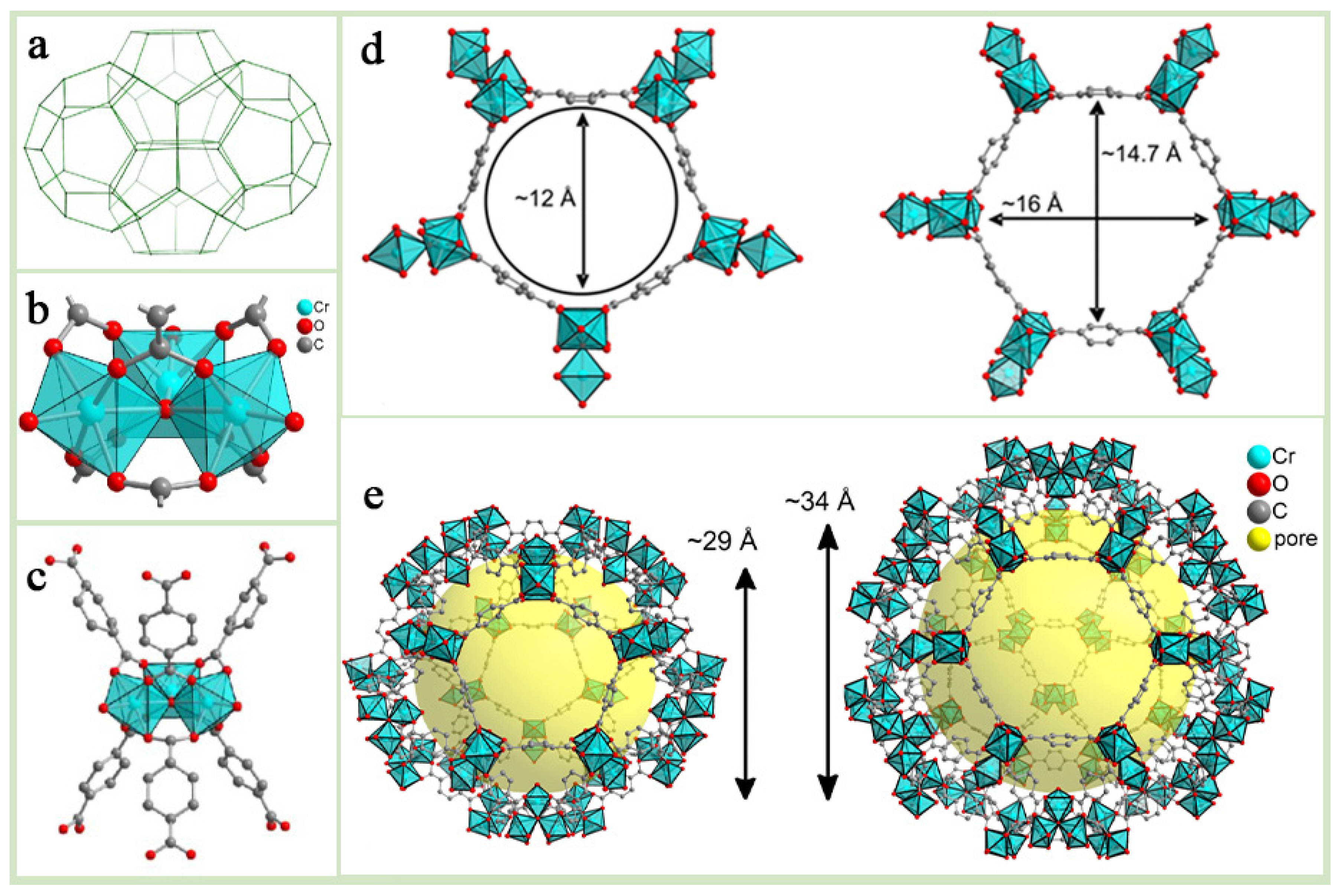
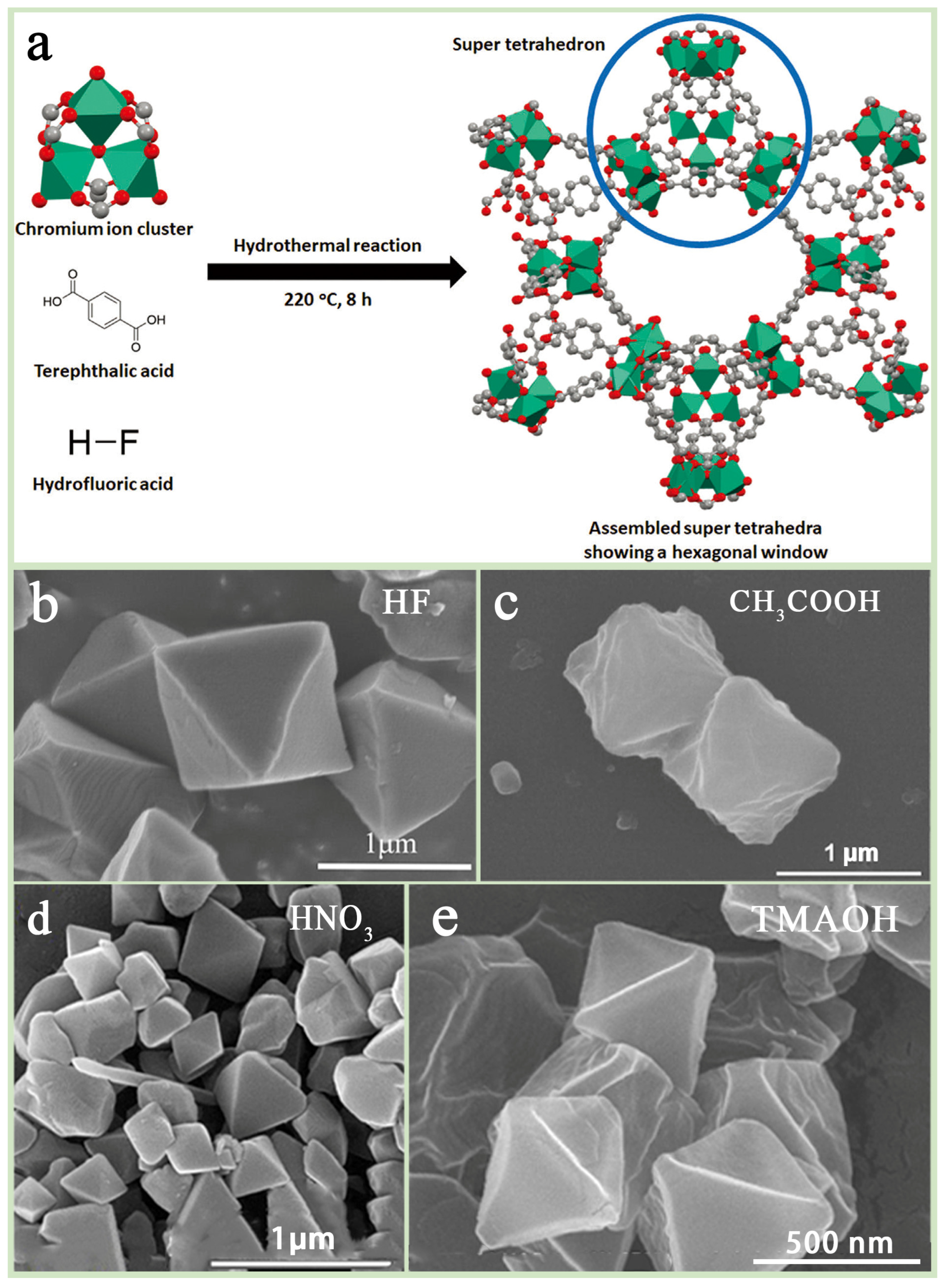
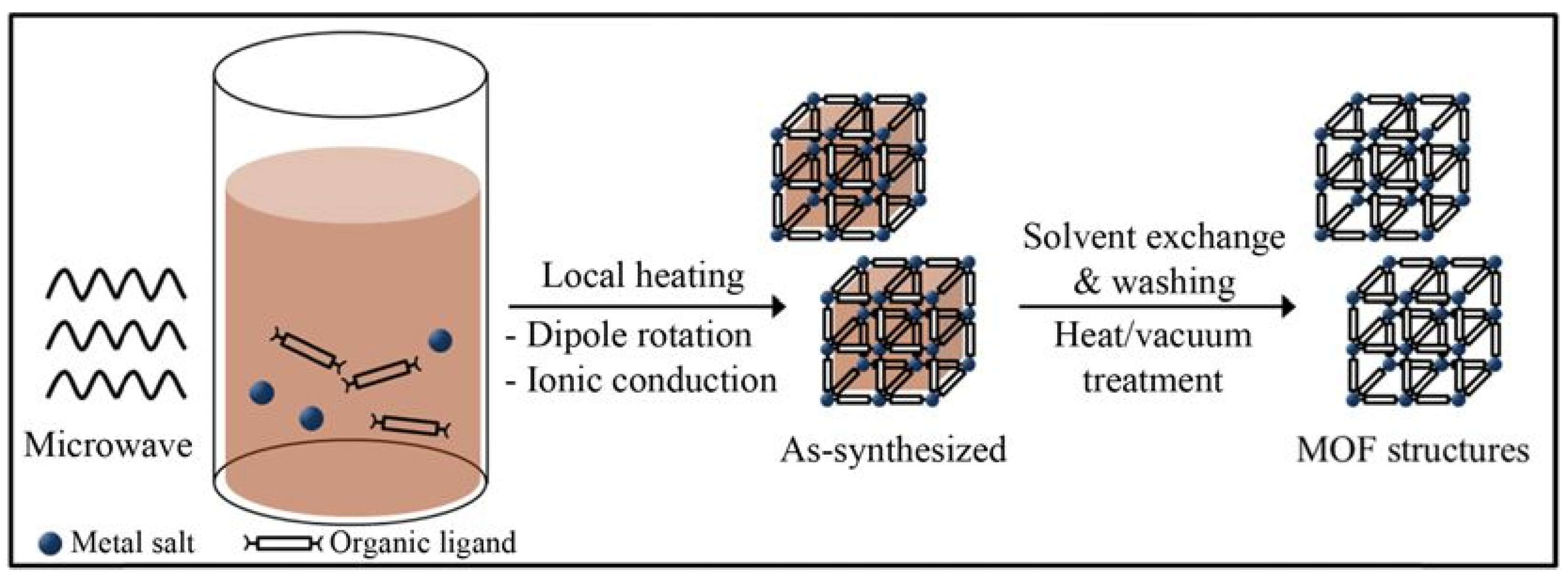

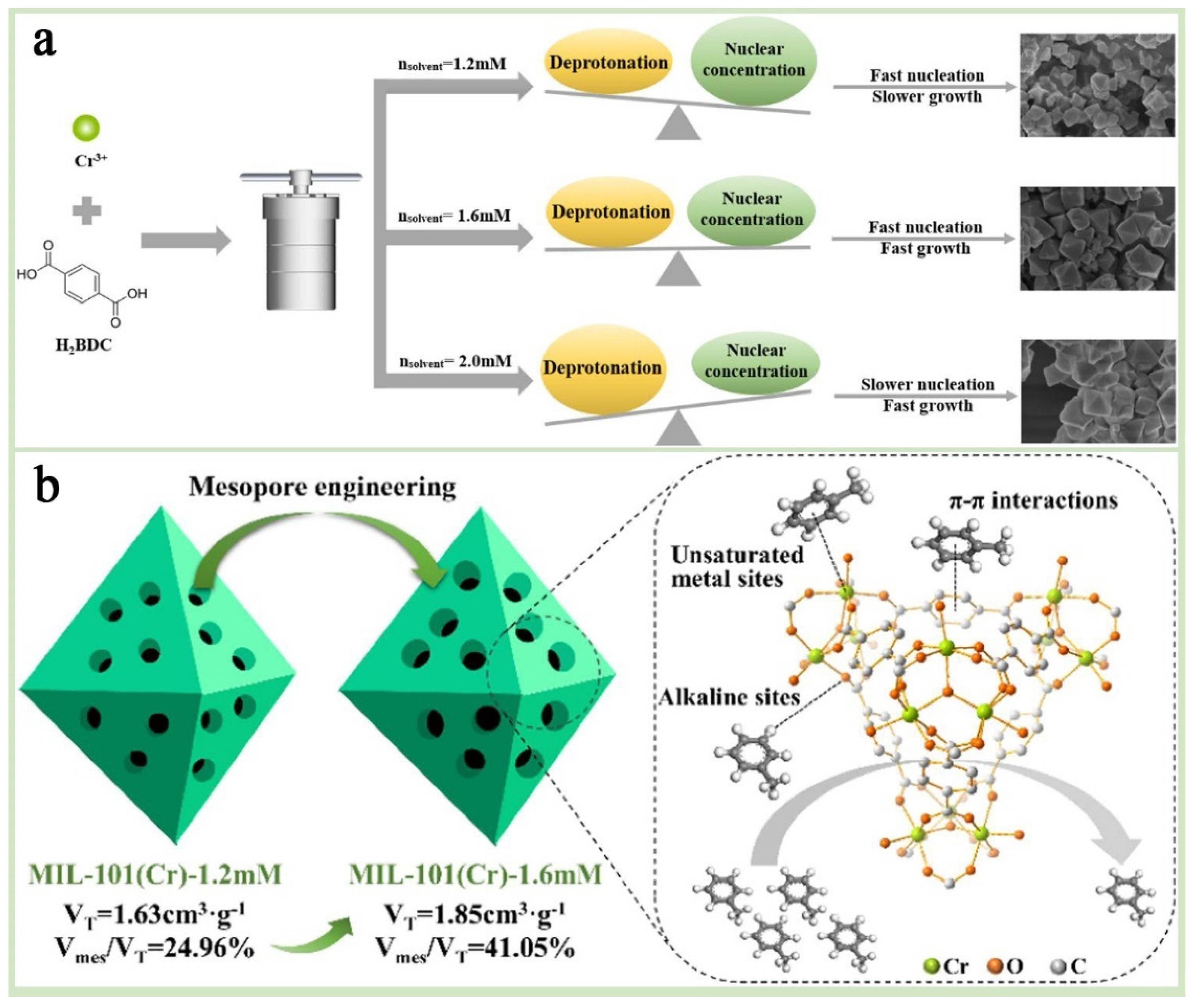

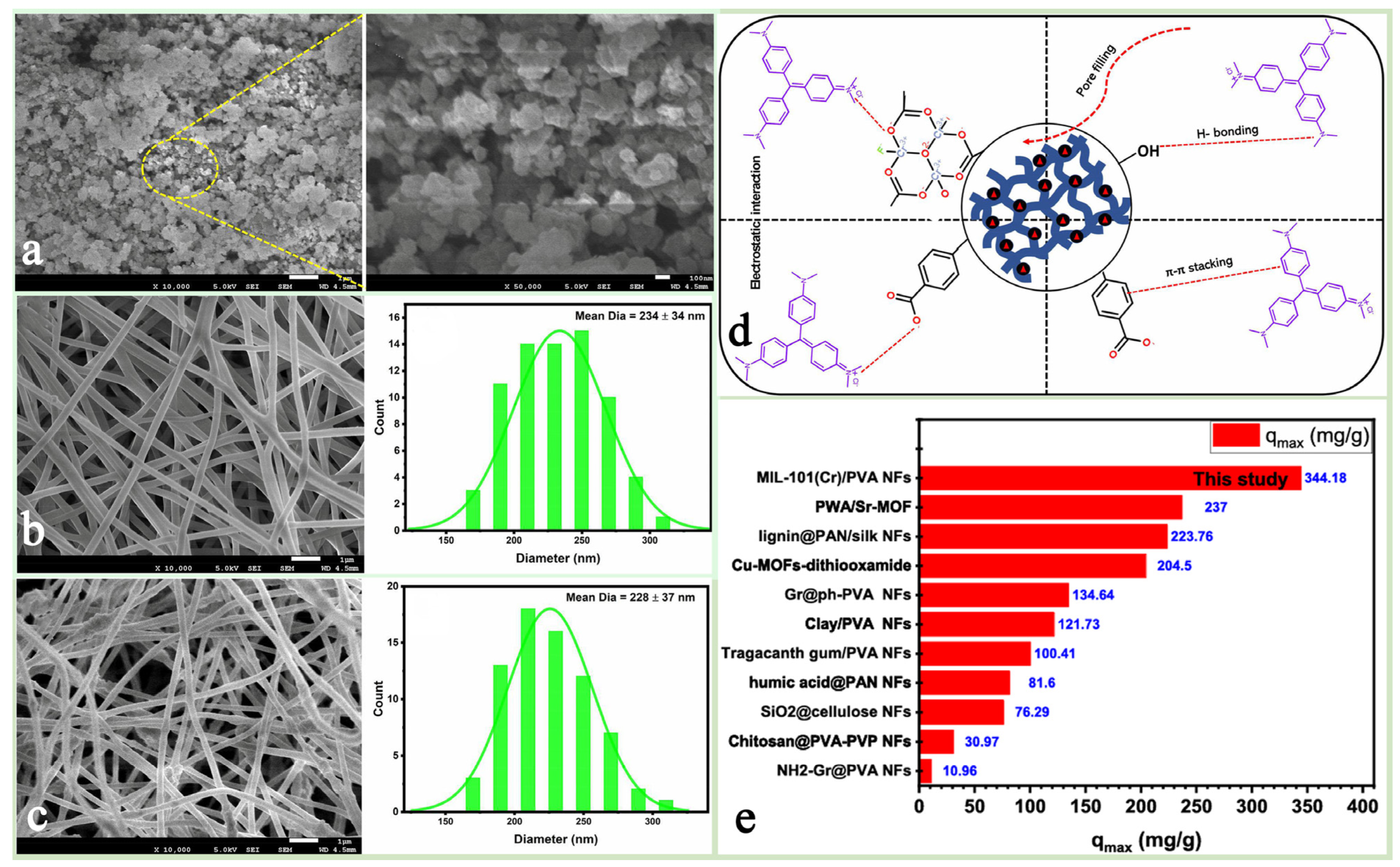
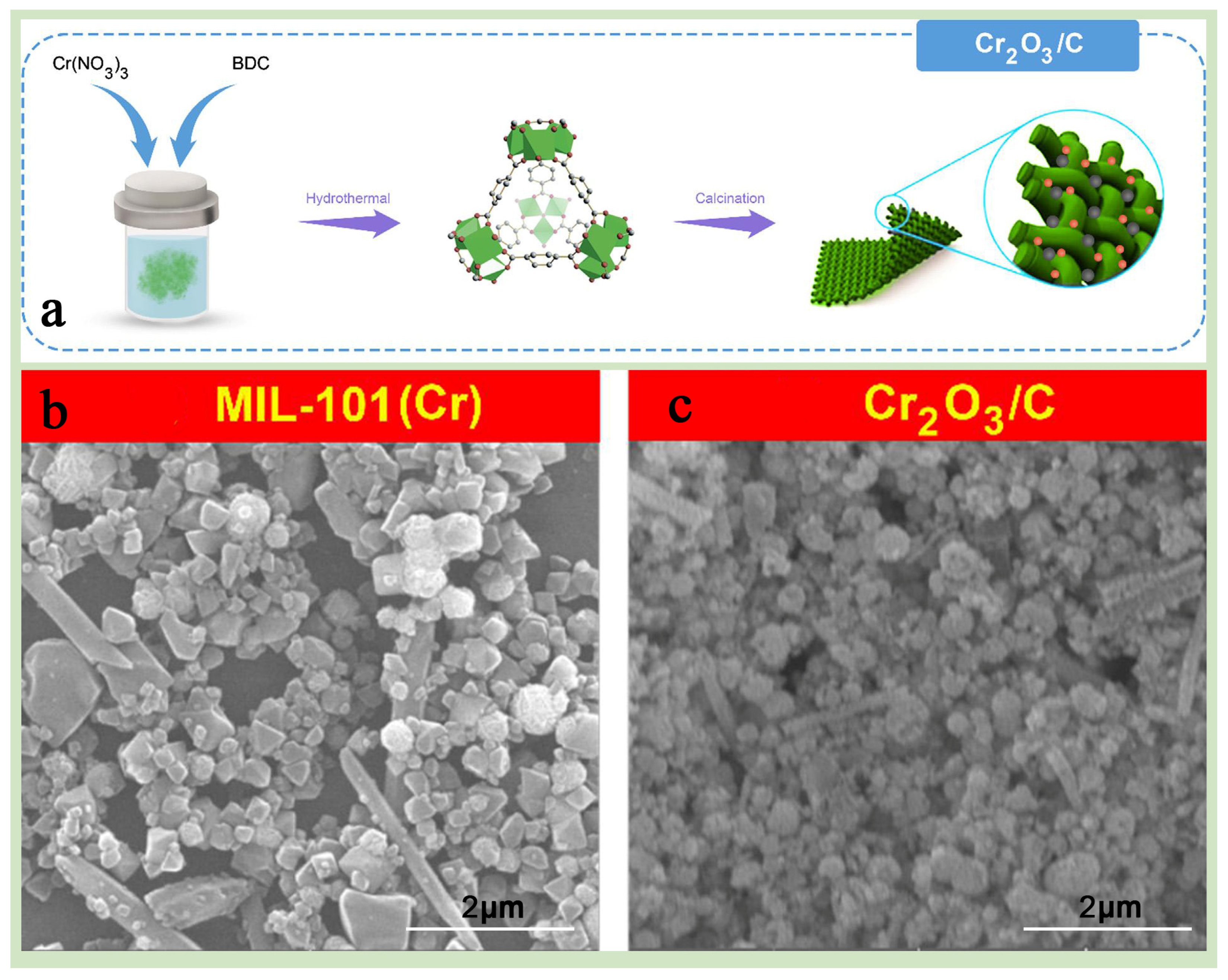
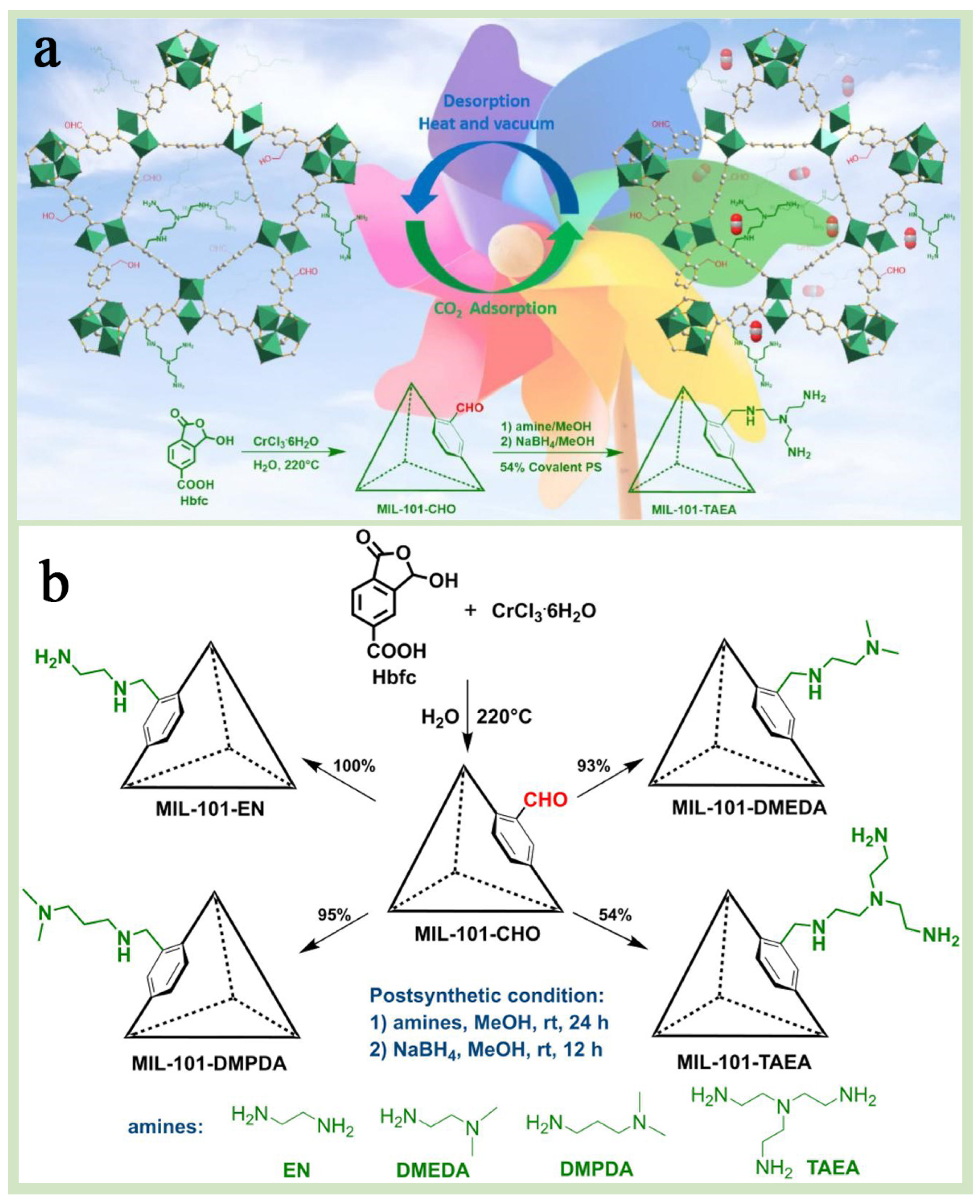

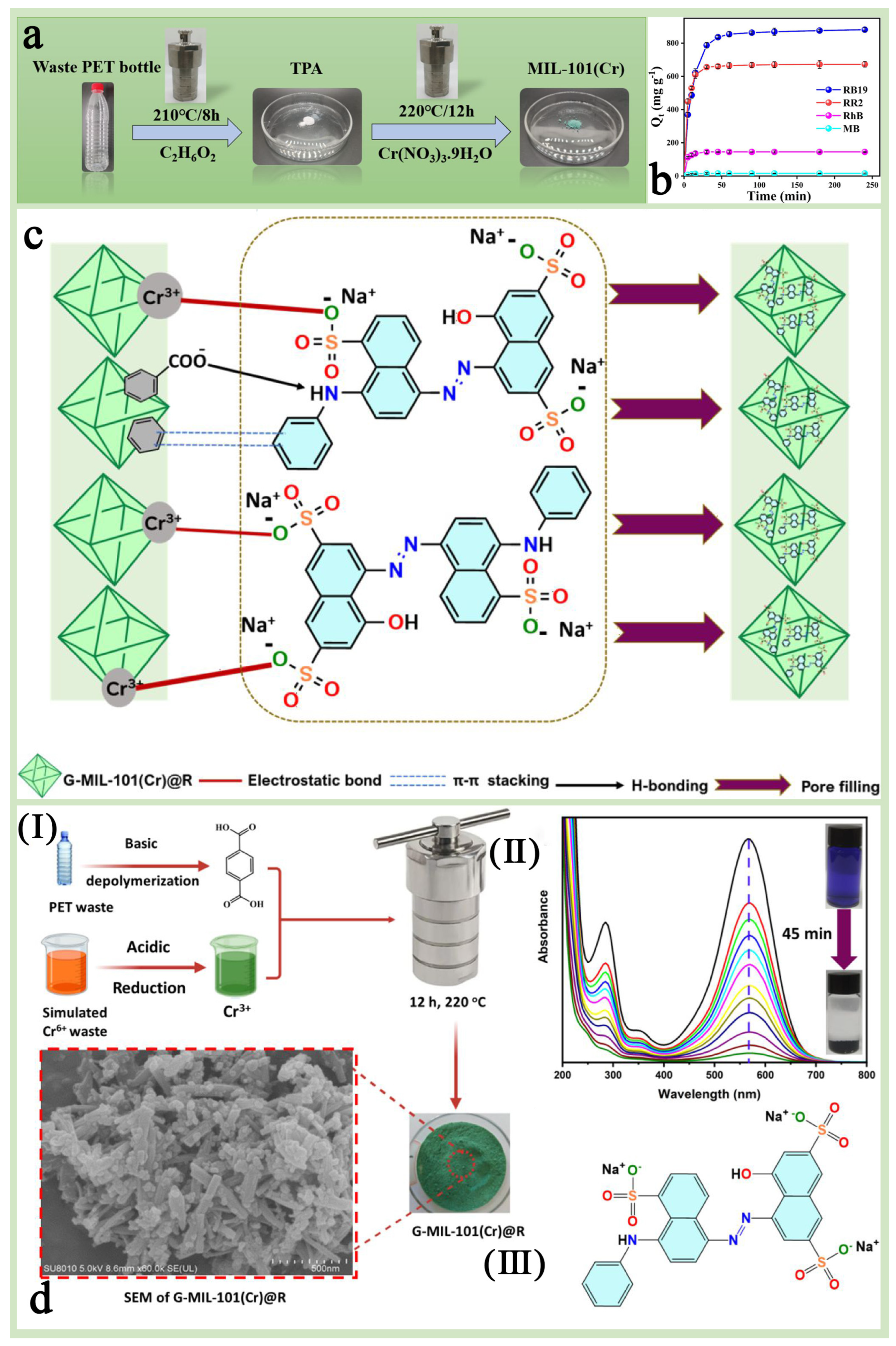


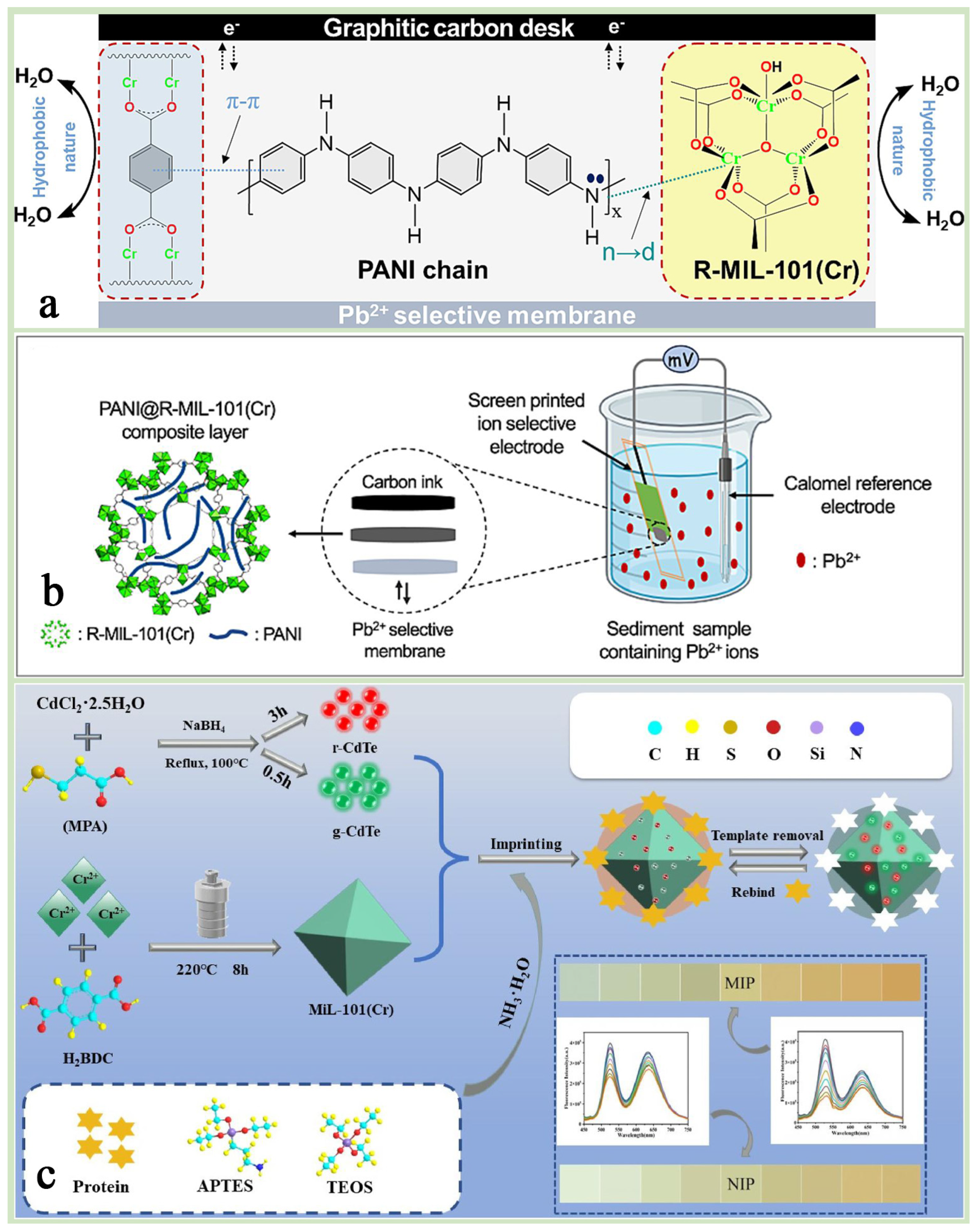
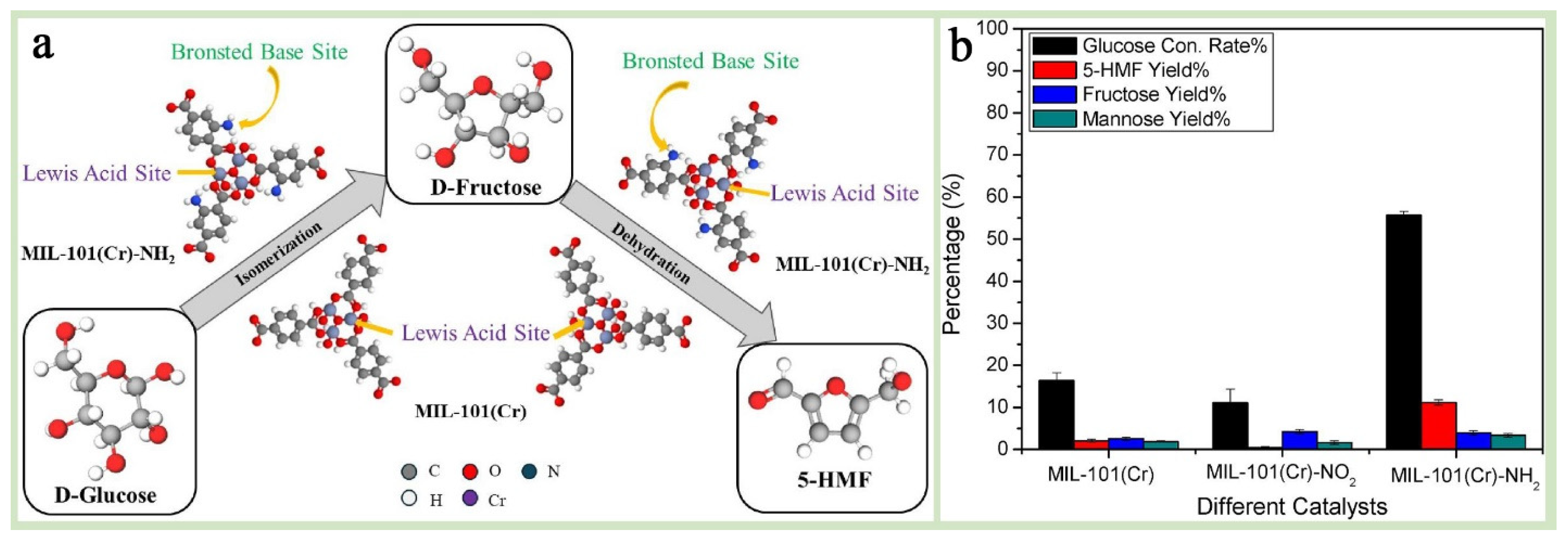

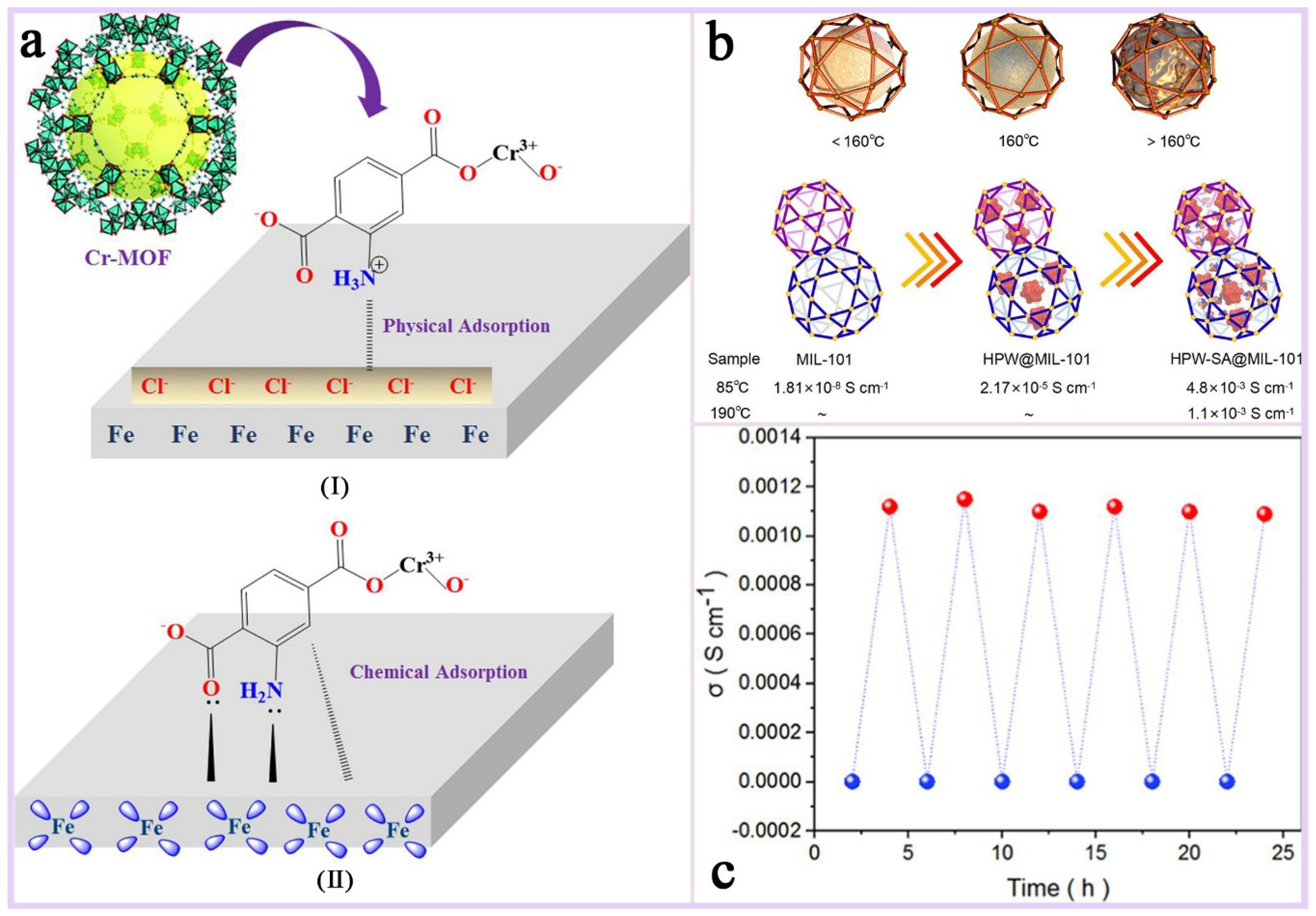
| Synthesis Method | Main Steps | Advantages | Drawbacks |
|---|---|---|---|
| Conventional hydrothermal method | 1. Mix a certain molar ratio of terephthalic acid (TPA), Cr(NO3)3-9H2O, and water and add a small amount of fluoride (e.g., HF or NH4F) as a mineralizing agent. 2. Place the mixture in a PTFE-lined stainless steel reactor and let it react at 180–220 °C for 12–48 h. 3. At the end of the reaction, wash the product with solvent and dry to obtain MIL-101(Cr). | The operation is relatively simple and suitable for large-scale synthesis; the product has high crystallinity and good pore structure. | The use of highly corrosive mineralizers such as HF has high equipment requirements and poses significant safety risks. There may be residual fluoride ions in the product. |
| Microwave-assisted hydrothermal method | 1. Dissolve TPA, Cr(NO3)3-9H2O, and mineralizer (optional) in water and stir well. 2. Place the mixed solution in a microwave reactor and let it react at 100–180 °C for 5–30 min. 3. At the end of the reaction, wash and dry to obtain MIL-101(Cr). | The reaction time is short, and the synthesis efficiency is high; the crystallinity and pore structure of the products are comparable to those of the traditional hydrothermal method. | Specialized microwave equipment is required, which is costly; the control of reaction conditions is demanding. |
| Template hydrothermal method | 1. During the synthesis process, guide MIL-101(Cr) crystal growth using templates with specific three-dimensional structures (hard templates such as silica, carbon nanotubes, or soft templates such as surfactants, polymers, etc.). 2. Transfer the mixture to a reaction vessel and let it react at 160–220 °C for 6–48 h. 3. After the reaction is complete, remove the template agent by calcination or other methods to obtain MIL-101(Cr) with a specific pore structure and morphology. | The obtained MIL-101(Cr) has a tunable crystal structure and pore morphology, which can effectively improve the adsorption and catalytic properties; nanoscale materials can be prepared. | The synthesis steps are complex and costly; incomplete removal of templating agents may affect material properties. |
| Solvothermal method | 1. Mix a certain molar ratio of TPA, Cr(NO3)3-9H2O and an organic solvent (e.g., ethanol, DMF, etc.) and add a mineralizing agent. 2. Carry out the reaction at 180–220 °C for 12–48 h. At the end of the reaction, wash the product with solvent and dry to obtain MIL-101(Cr). | The use of organic solvents is suitable for the synthesis of water-sensitive compounds; the products have better crystallinity and pore structure. | Requires the use of organic solvents, higher cost, and risk of environmental pollution; reaction conditions are more demanding. |
| Mechanochemical synthesis method | 1. Grinding of mixtures of metal precursors and organic linkers by mechanical force (e.g., mortar and pestle or ball mill) 2. Several hours in a high-pressure heater | No need to use solvents, green environmental protection characteristics; short reaction time, suitable for continuous production; small particle size of the product. | Lower crystallinity and mechanical forces tend to induce by-products; uneven input of mechanical energy may lead to crystal crystallization; control of industrial production ball mills is challenging. |
Disclaimer/Publisher’s Note: The statements, opinions and data contained in all publications are solely those of the individual author(s) and contributor(s) and not of MDPI and/or the editor(s). MDPI and/or the editor(s) disclaim responsibility for any injury to people or property resulting from any ideas, methods, instructions or products referred to in the content. |
© 2025 by the authors. Licensee MDPI, Basel, Switzerland. This article is an open access article distributed under the terms and conditions of the Creative Commons Attribution (CC BY) license (https://creativecommons.org/licenses/by/4.0/).
Share and Cite
Chen, J.; Tang, M.; Nie, S.; Xiao, P.; Zhao, T.; Chen, Y. Synthesis Methods, Performance Optimization, and Application Progress of Metal–Organic Framework Material MIL-101(Cr). Chemistry 2025, 7, 78. https://doi.org/10.3390/chemistry7030078
Chen J, Tang M, Nie S, Xiao P, Zhao T, Chen Y. Synthesis Methods, Performance Optimization, and Application Progress of Metal–Organic Framework Material MIL-101(Cr). Chemistry. 2025; 7(3):78. https://doi.org/10.3390/chemistry7030078
Chicago/Turabian StyleChen, Jiayao, Min Tang, Saiqun Nie, Pengcheng Xiao, Tian Zhao, and Yi Chen. 2025. "Synthesis Methods, Performance Optimization, and Application Progress of Metal–Organic Framework Material MIL-101(Cr)" Chemistry 7, no. 3: 78. https://doi.org/10.3390/chemistry7030078
APA StyleChen, J., Tang, M., Nie, S., Xiao, P., Zhao, T., & Chen, Y. (2025). Synthesis Methods, Performance Optimization, and Application Progress of Metal–Organic Framework Material MIL-101(Cr). Chemistry, 7(3), 78. https://doi.org/10.3390/chemistry7030078







